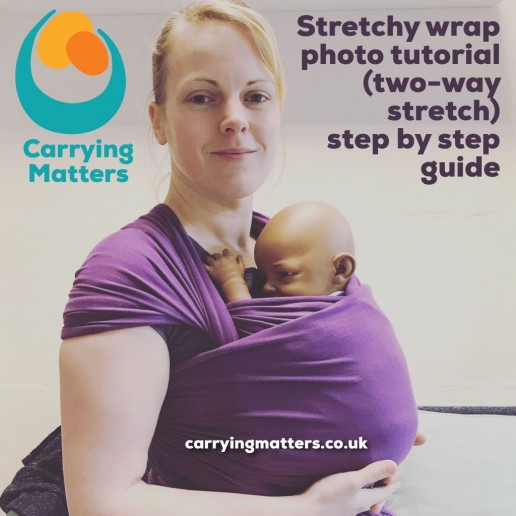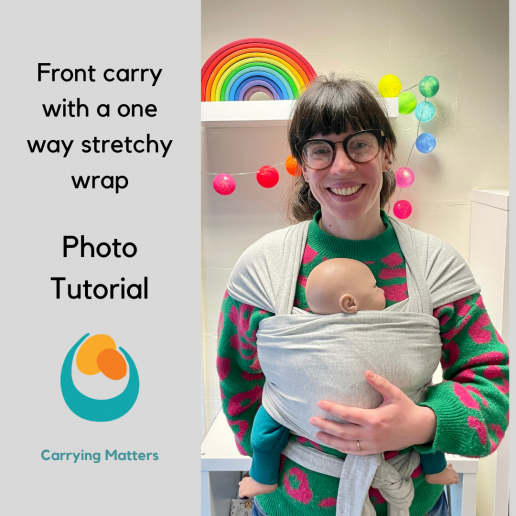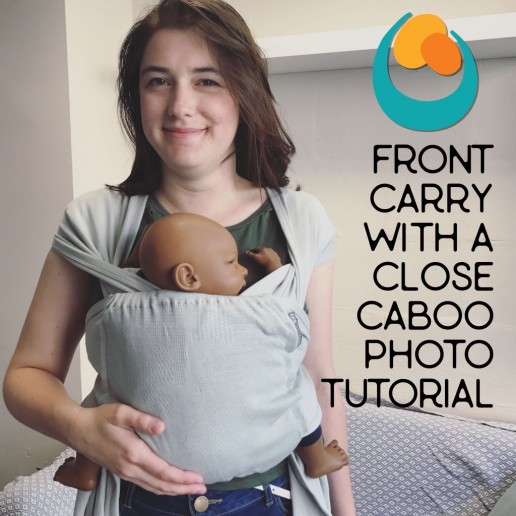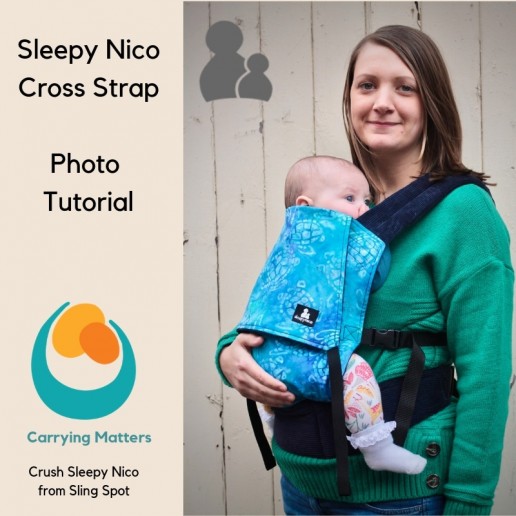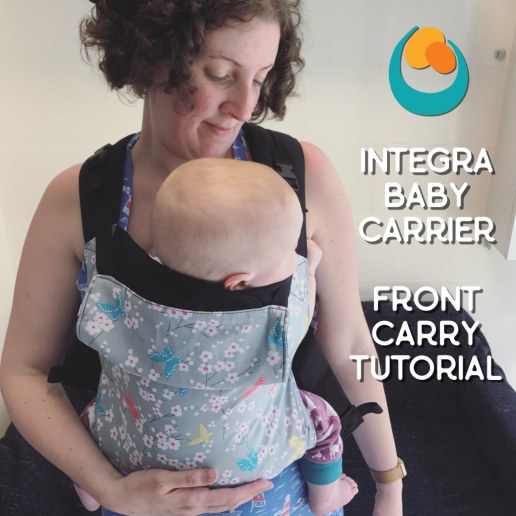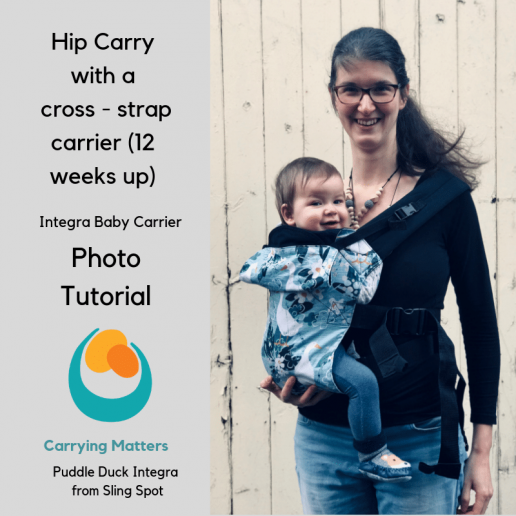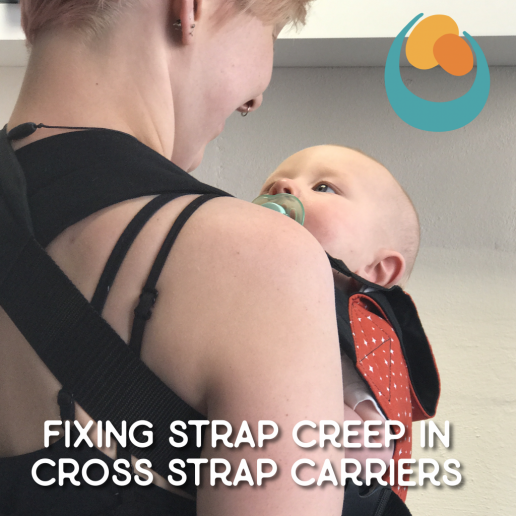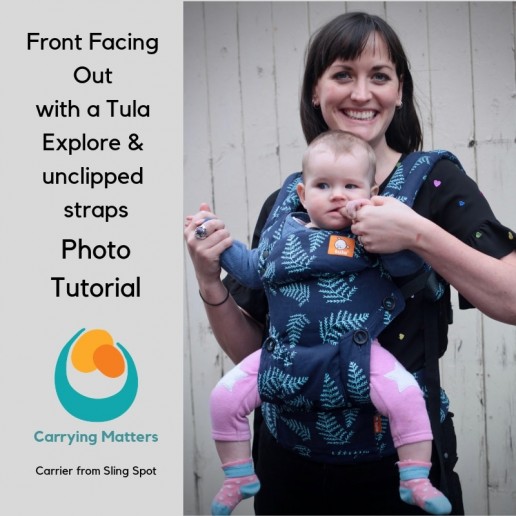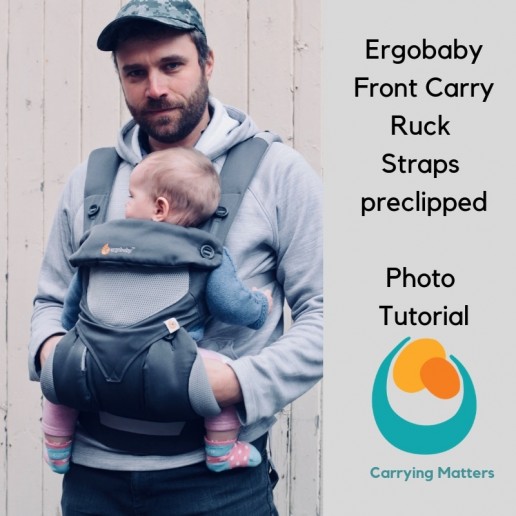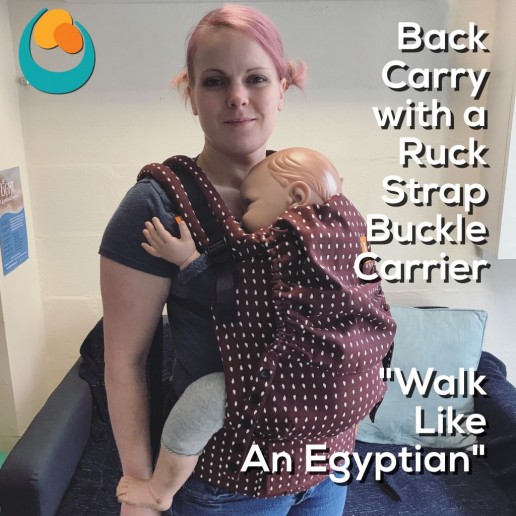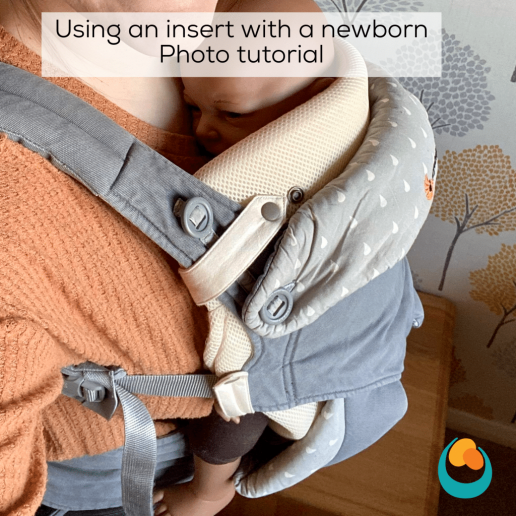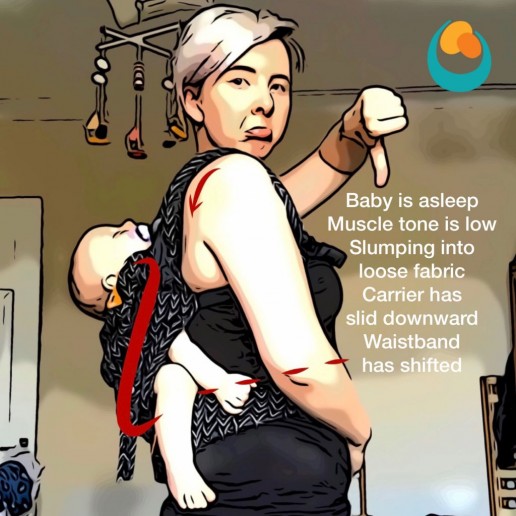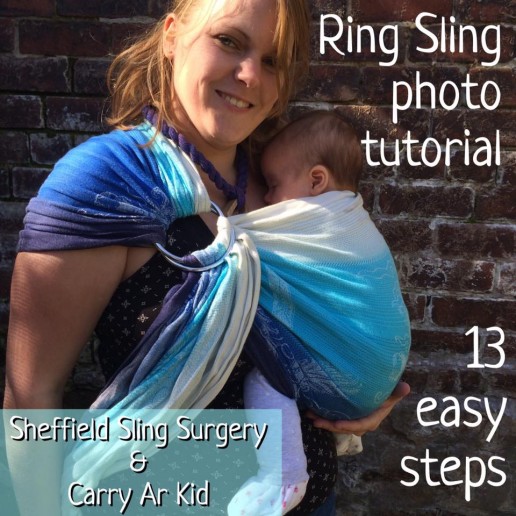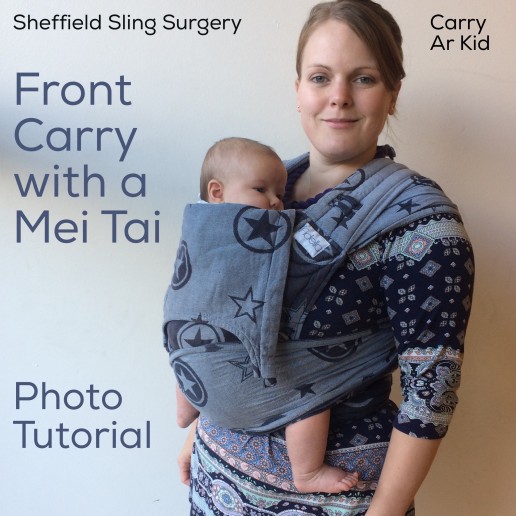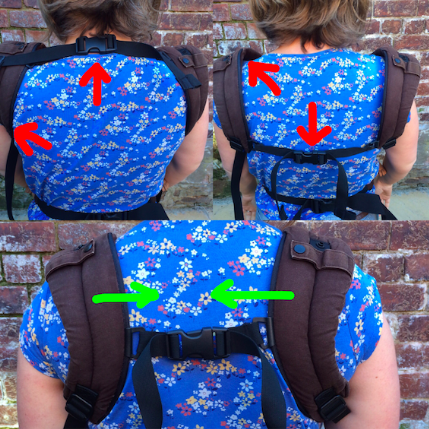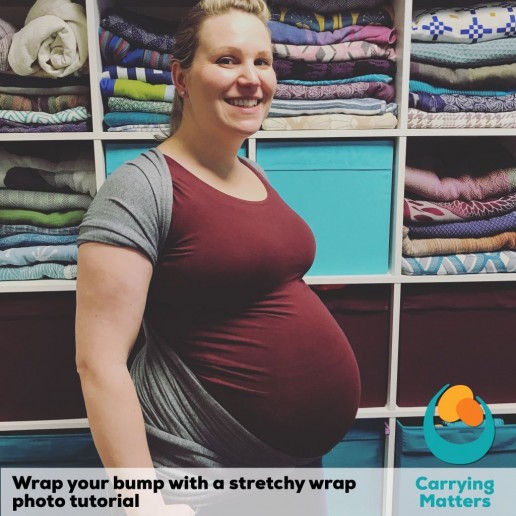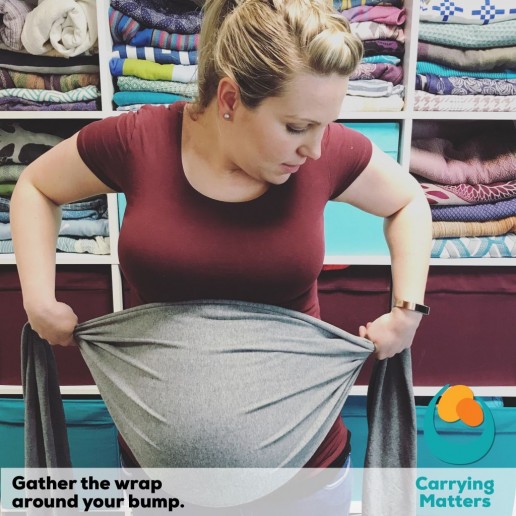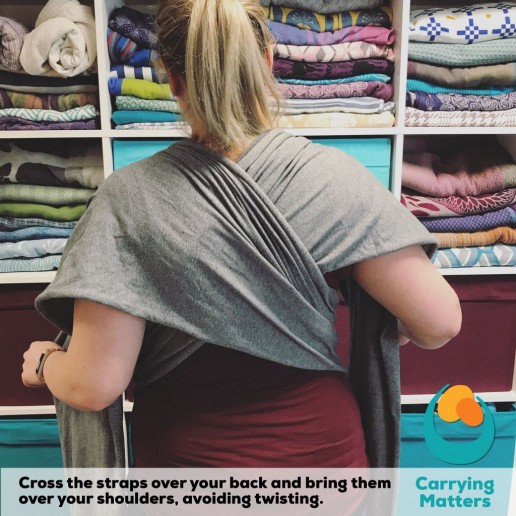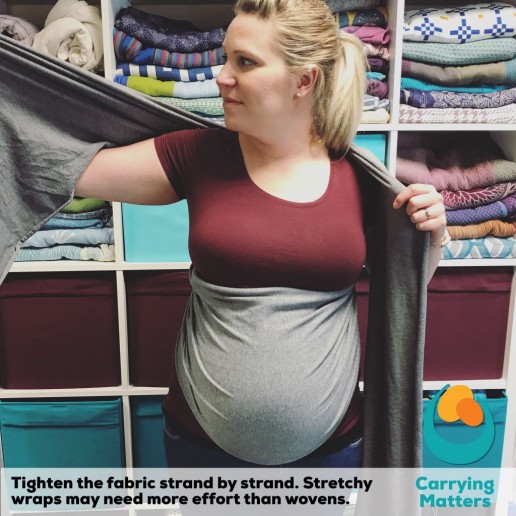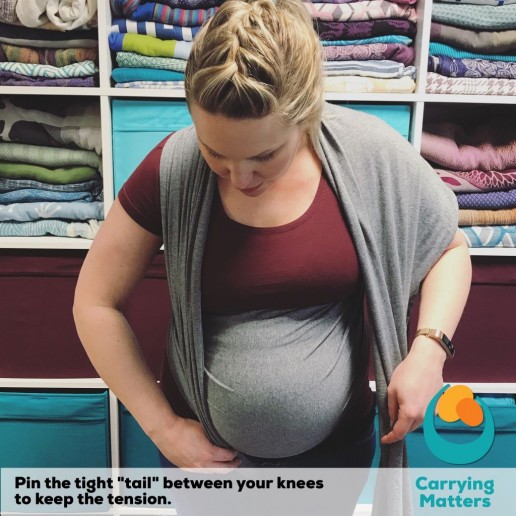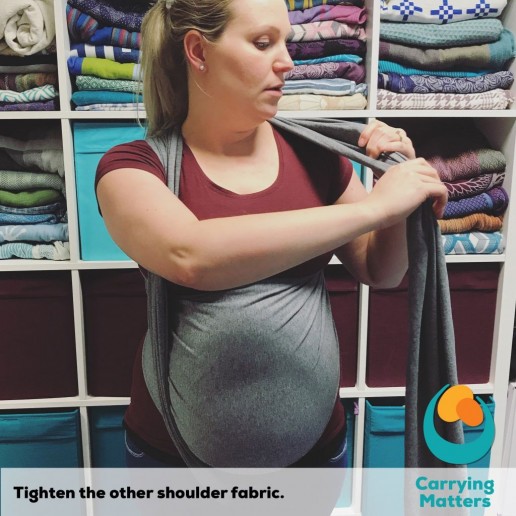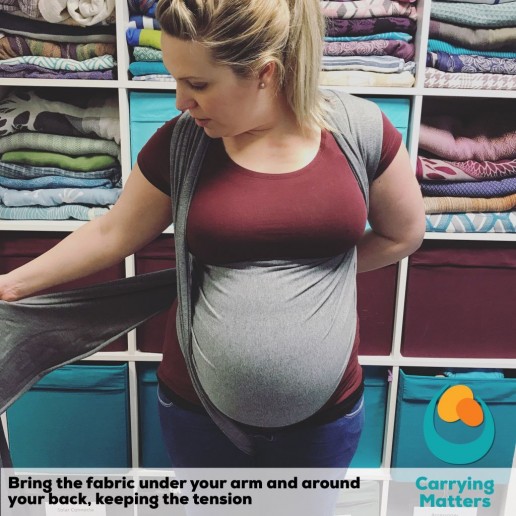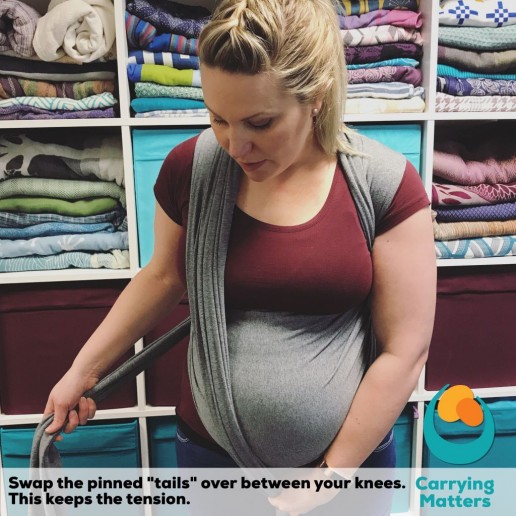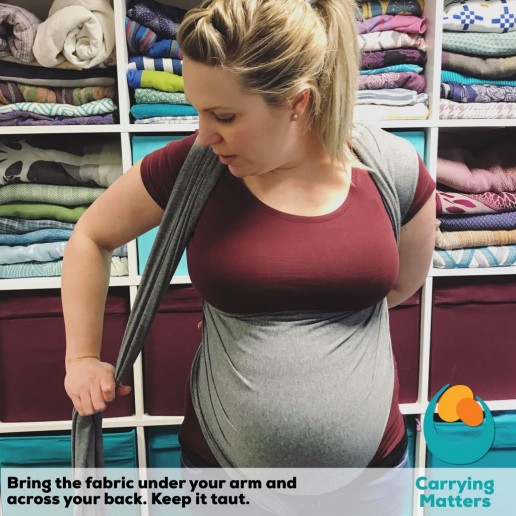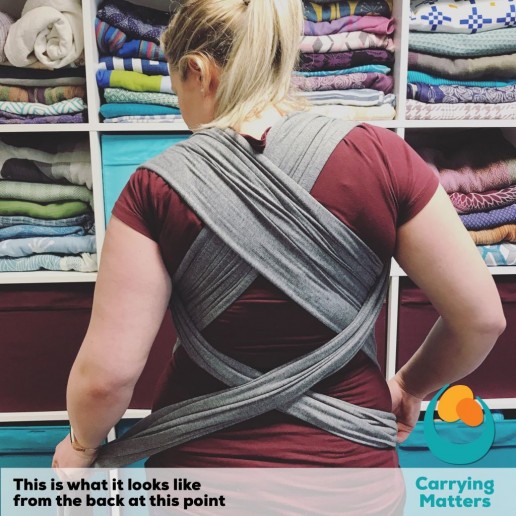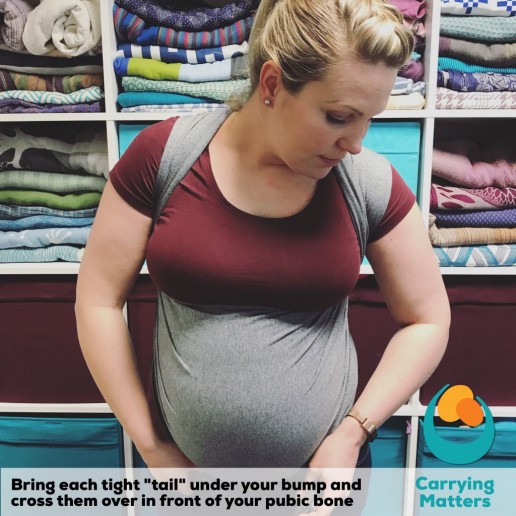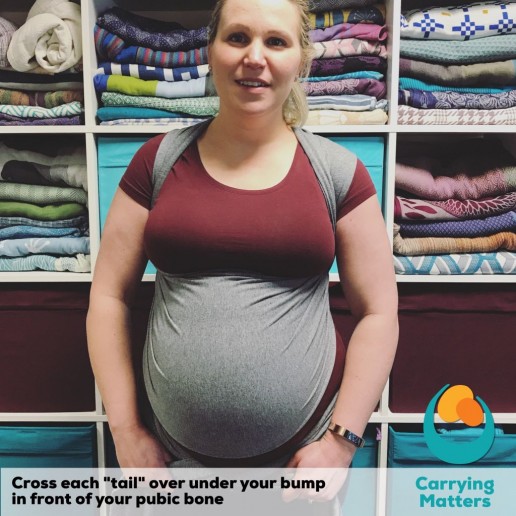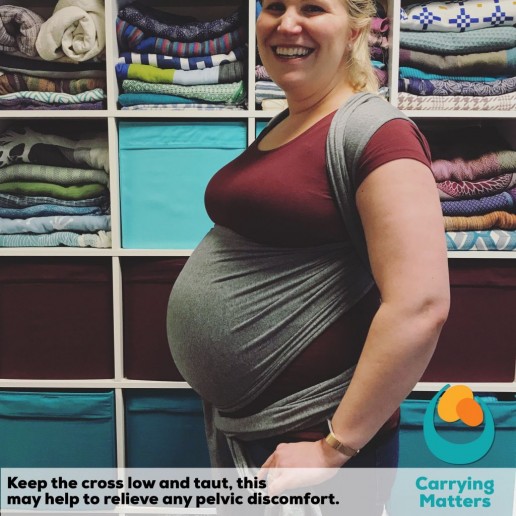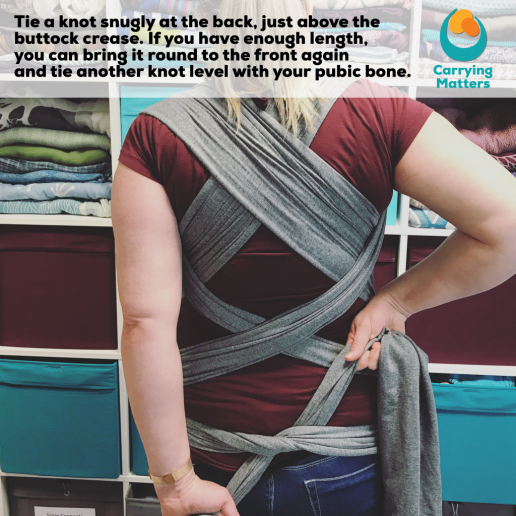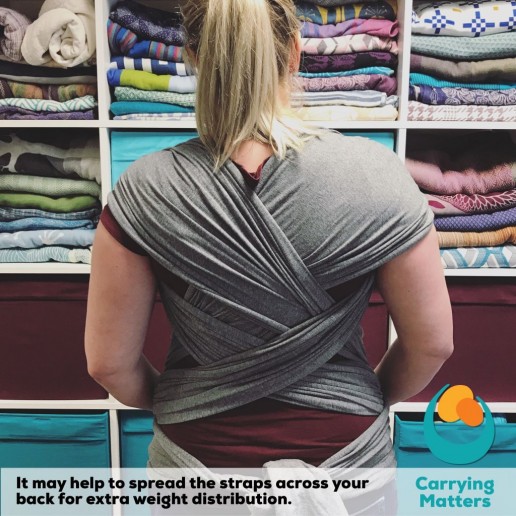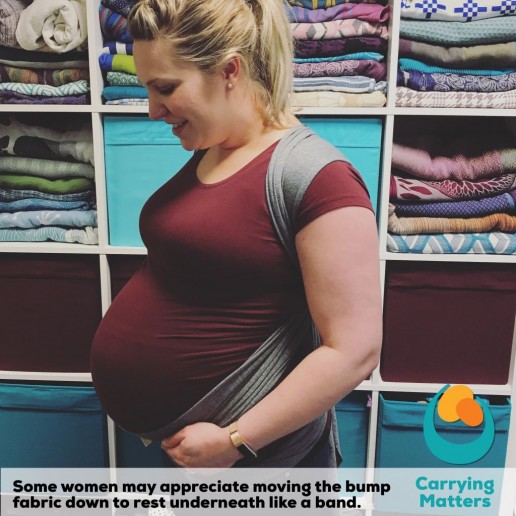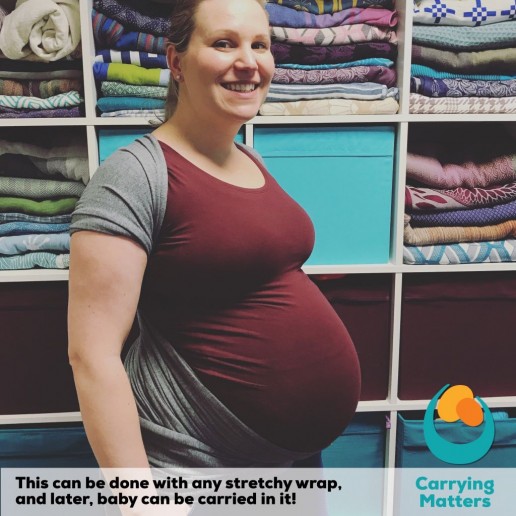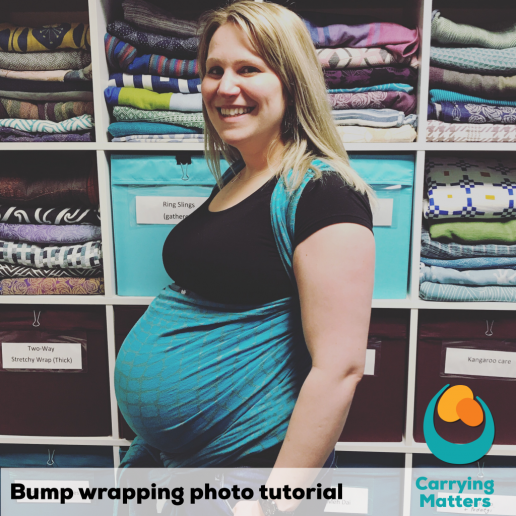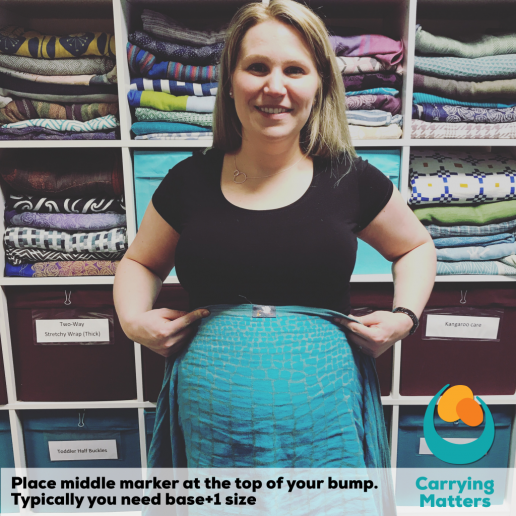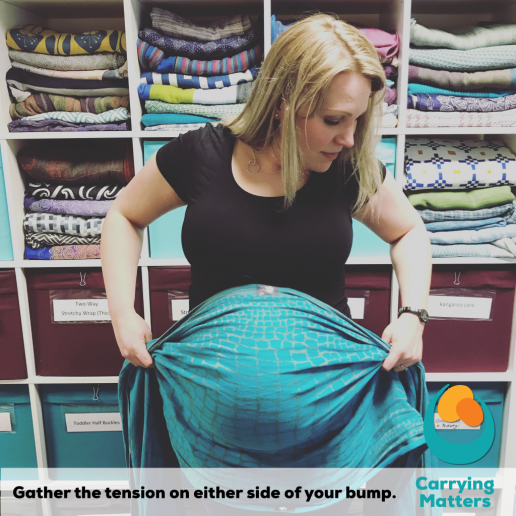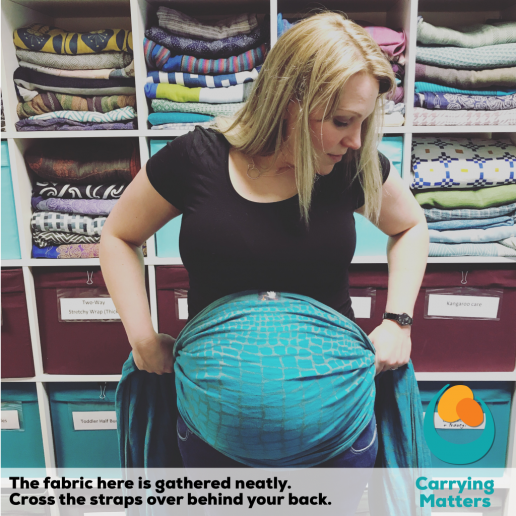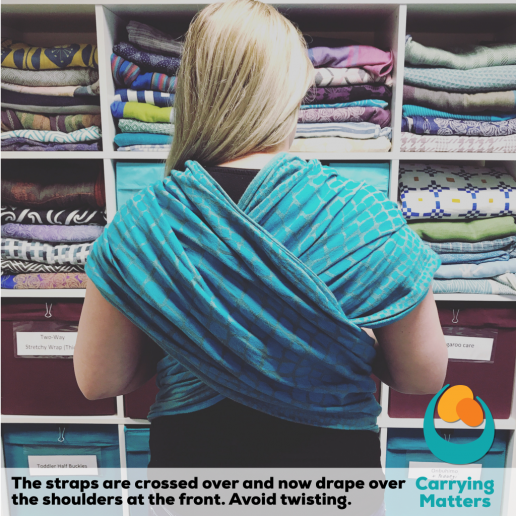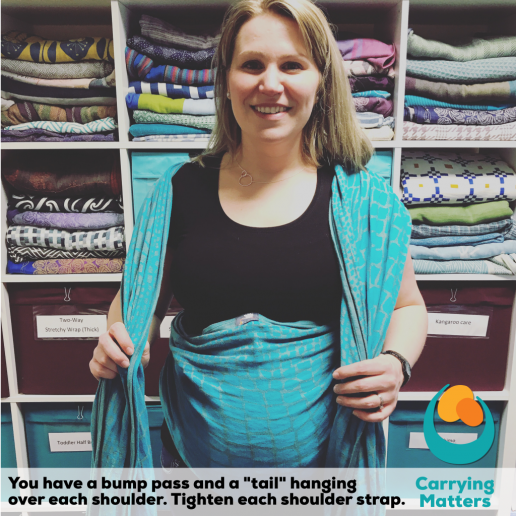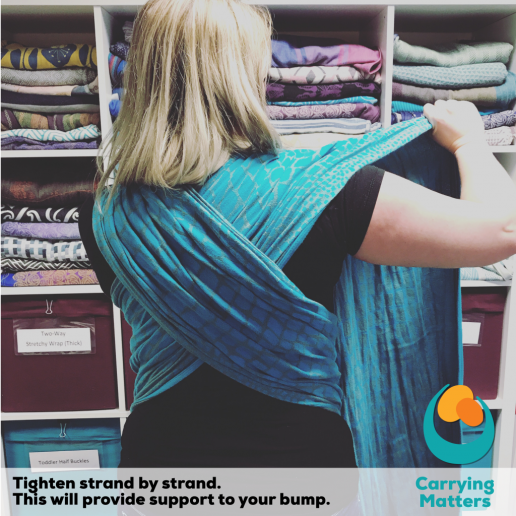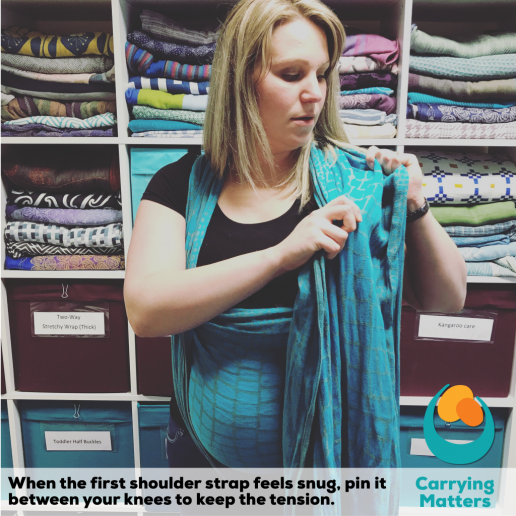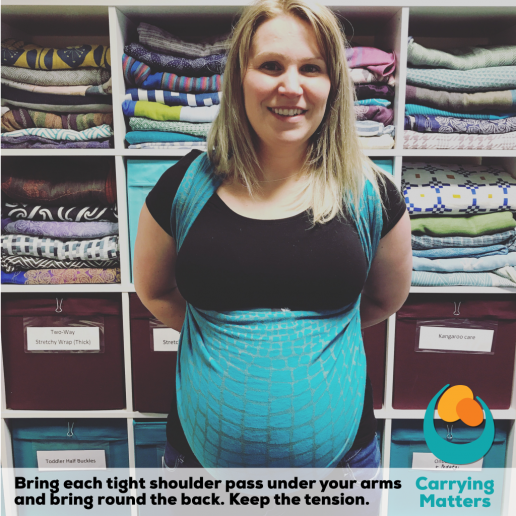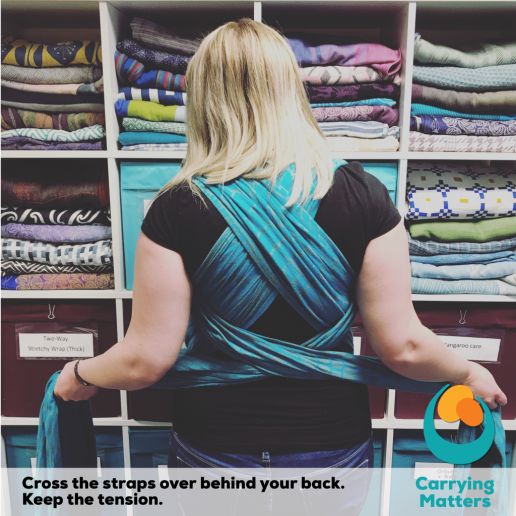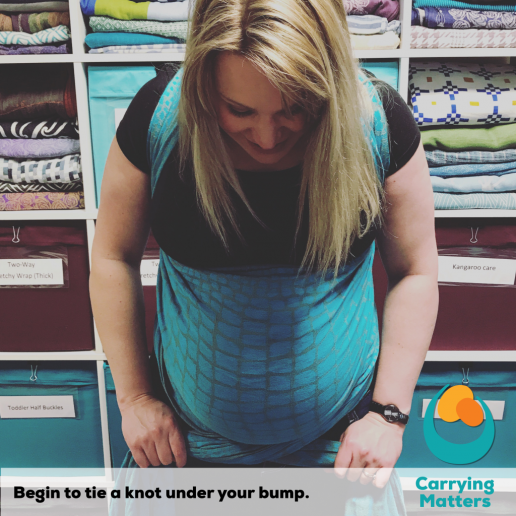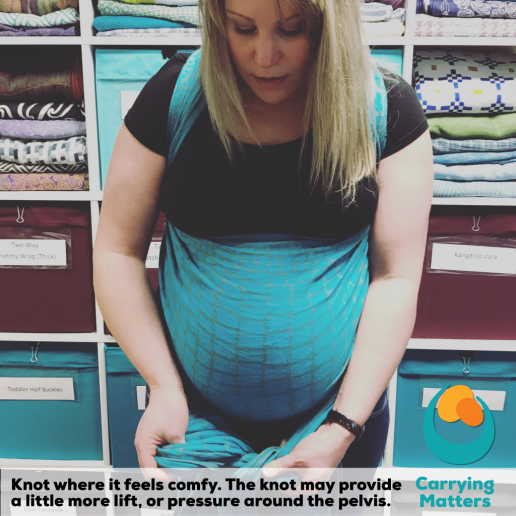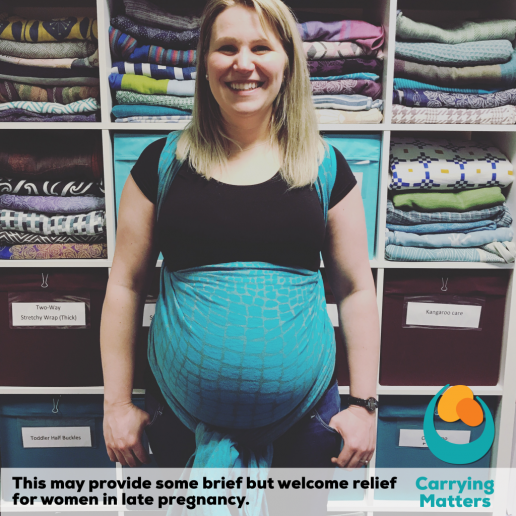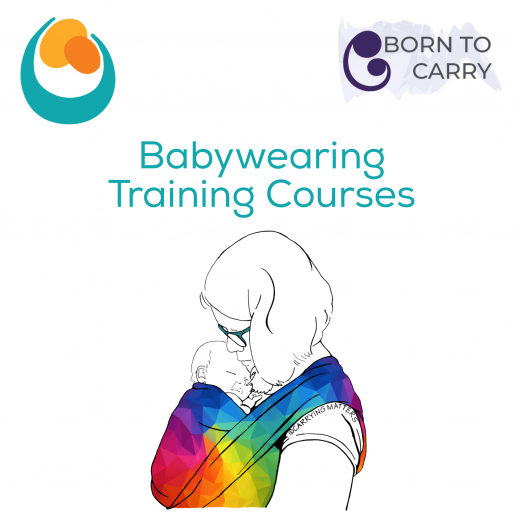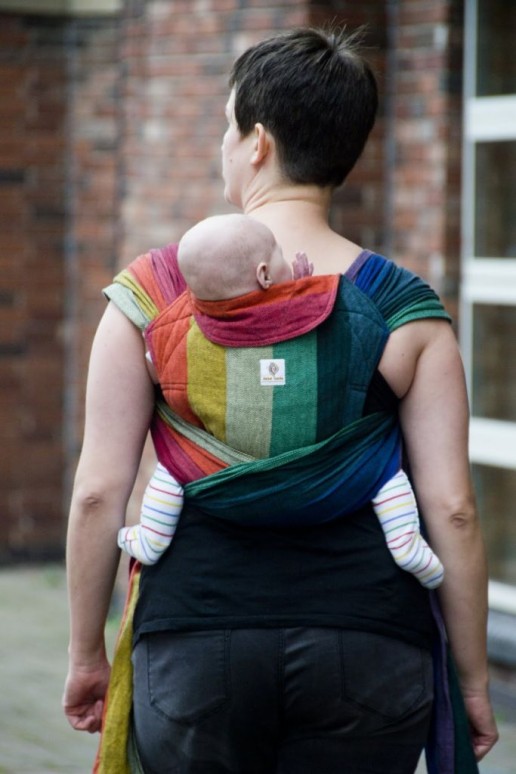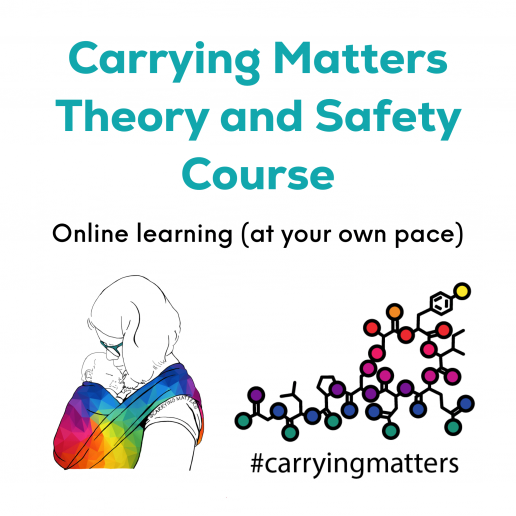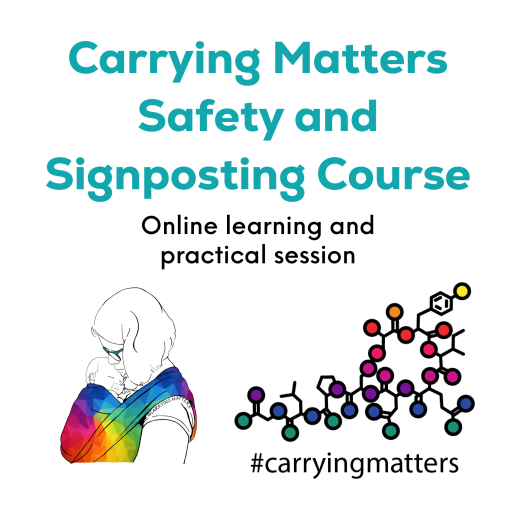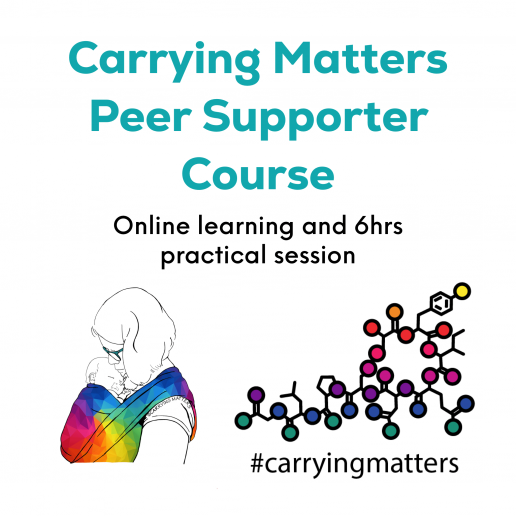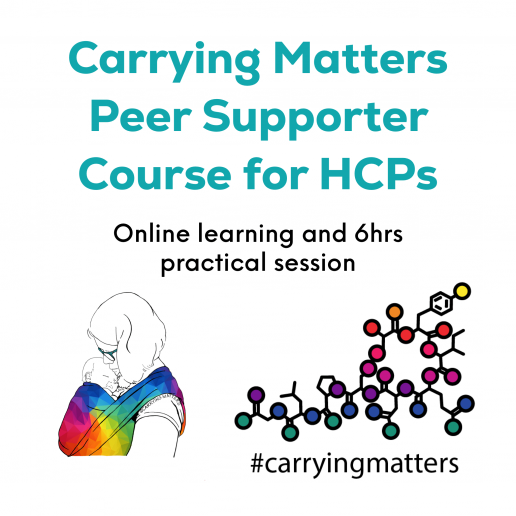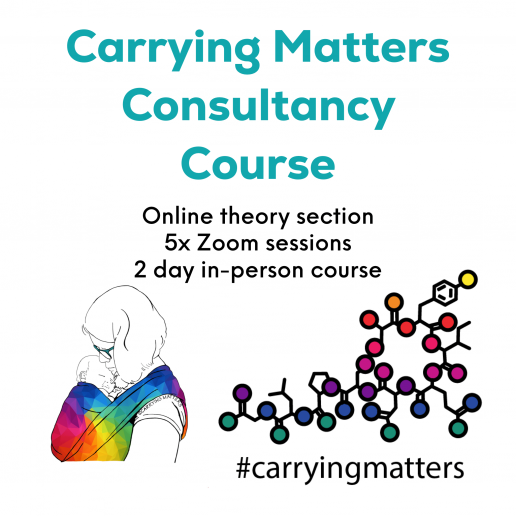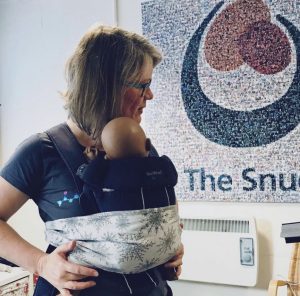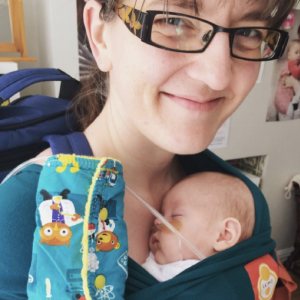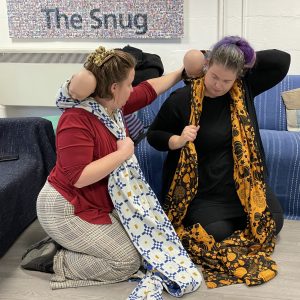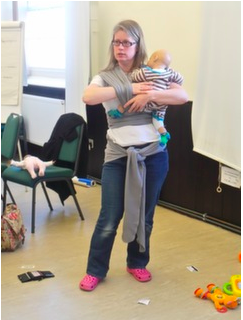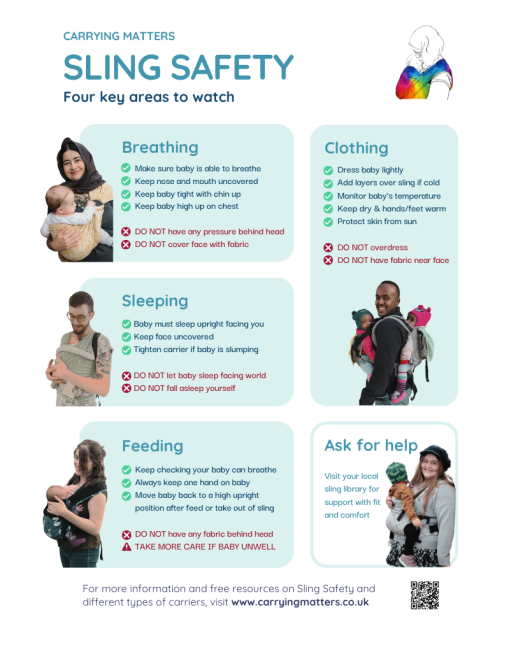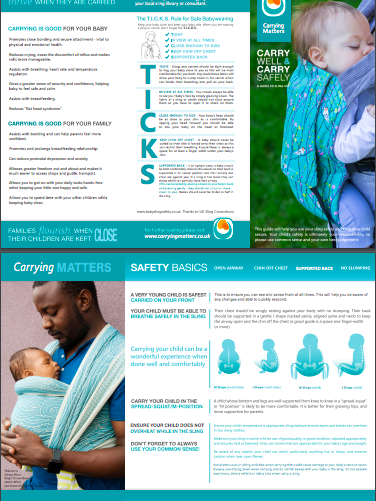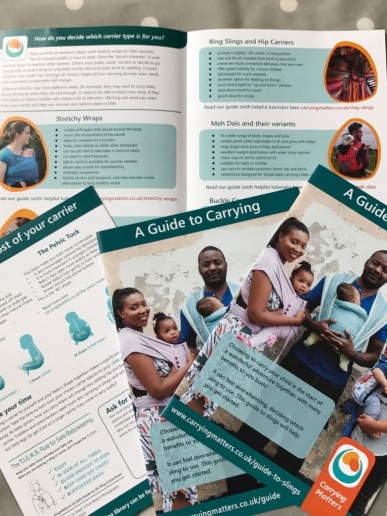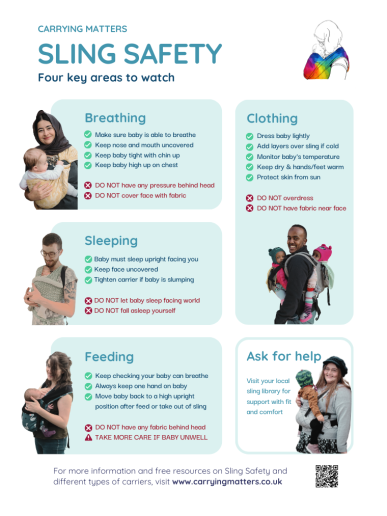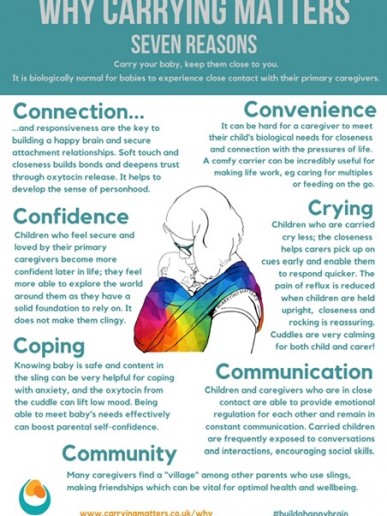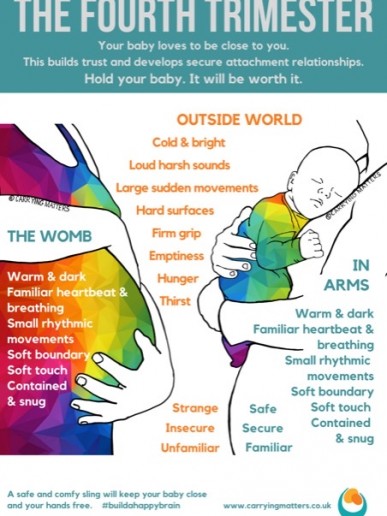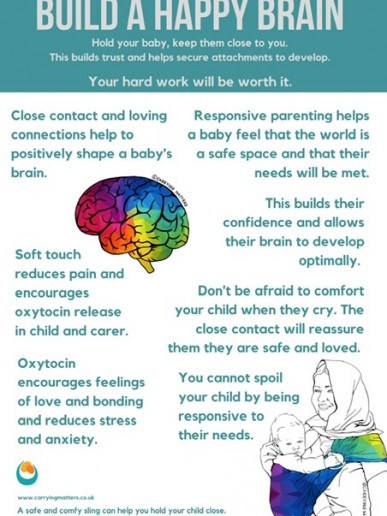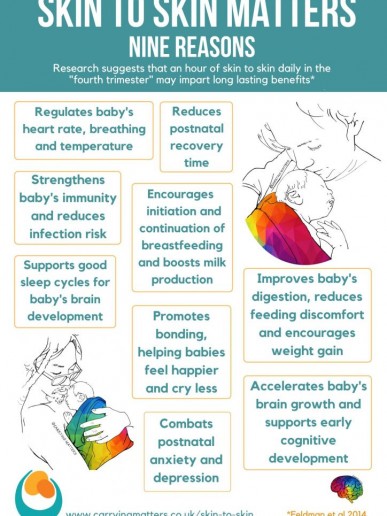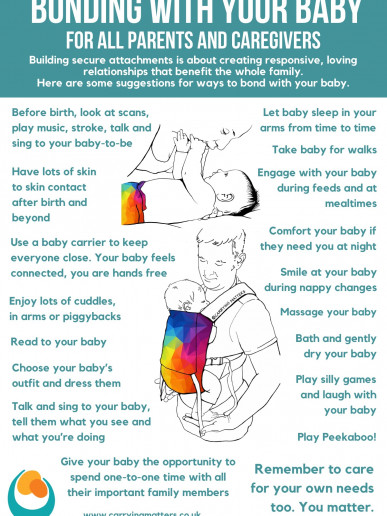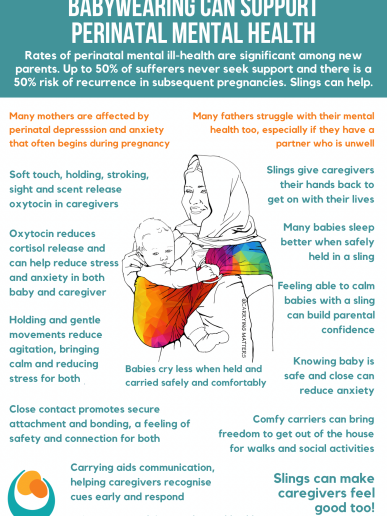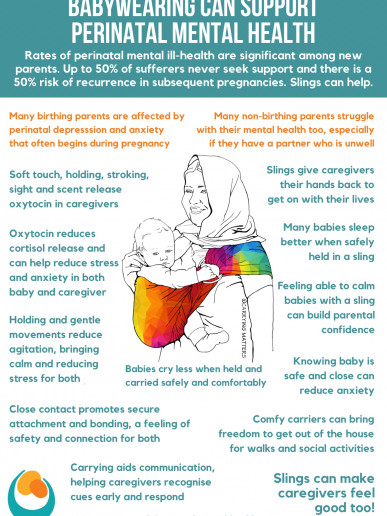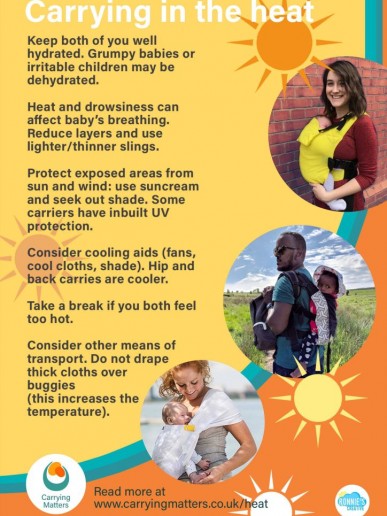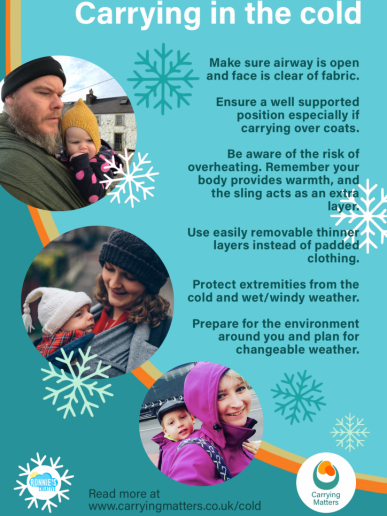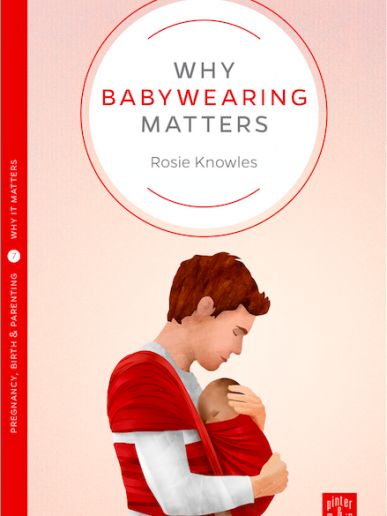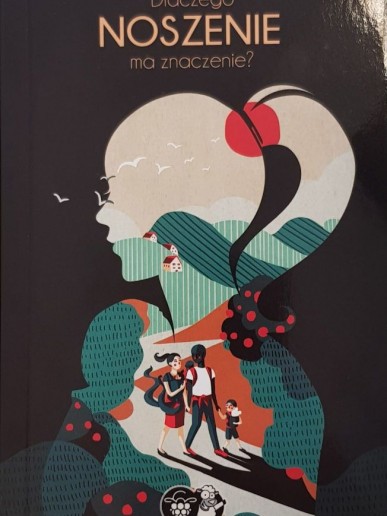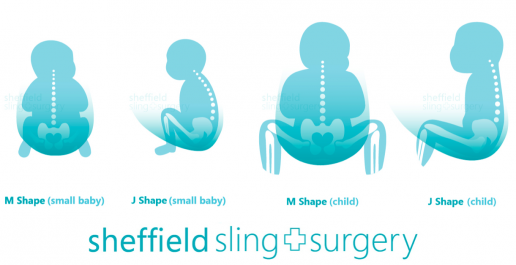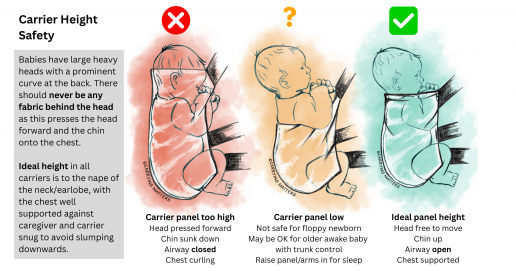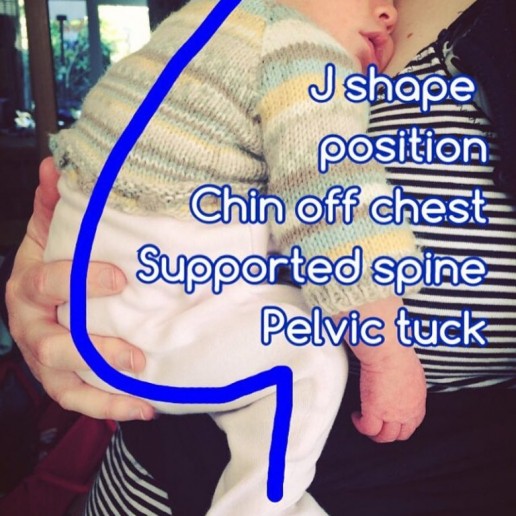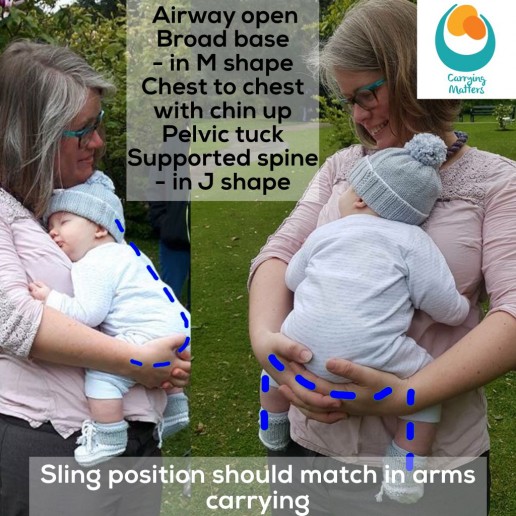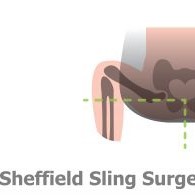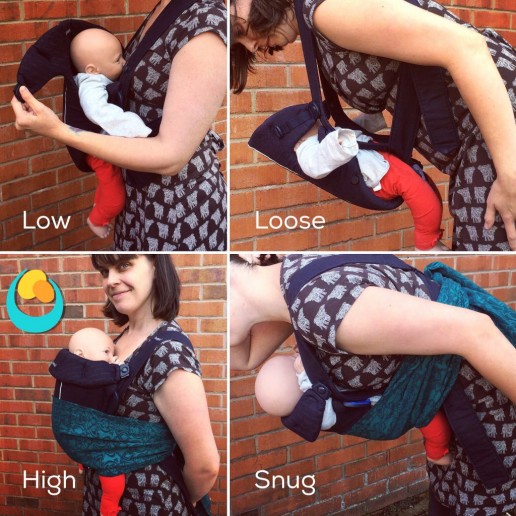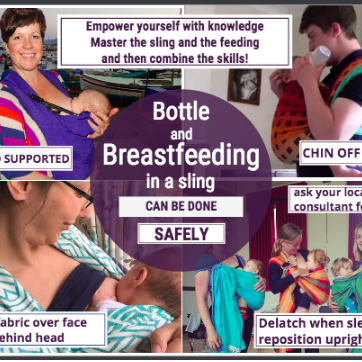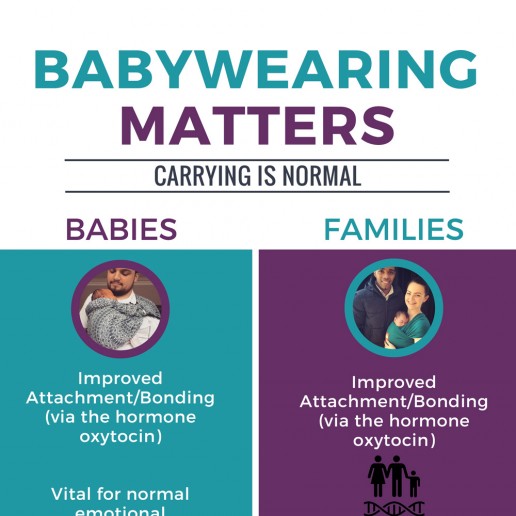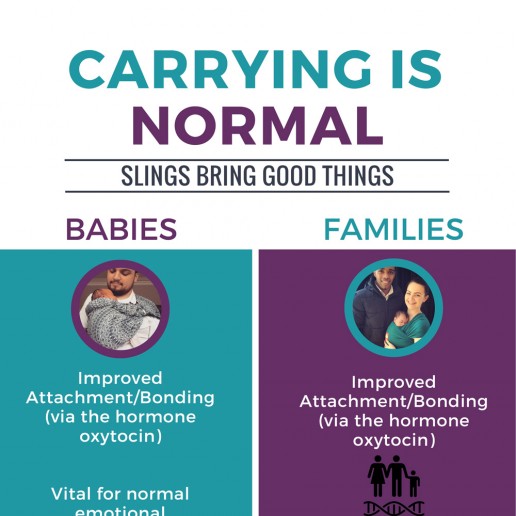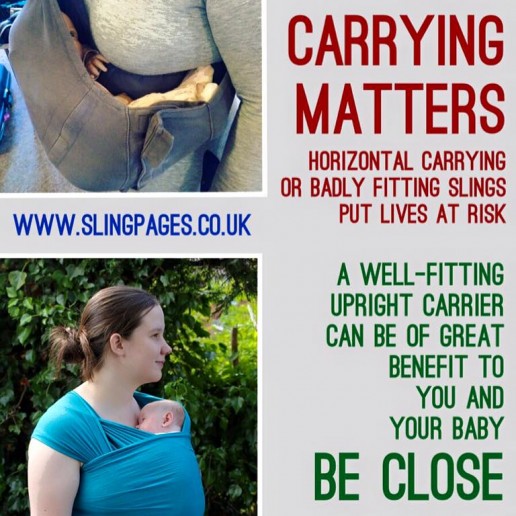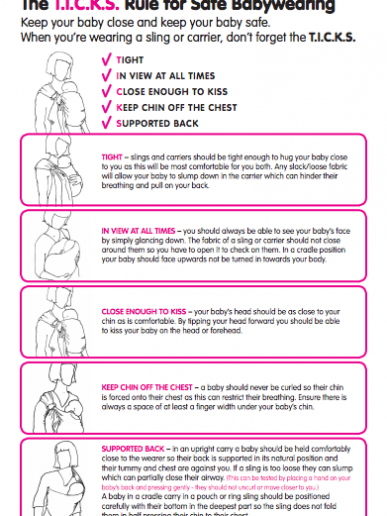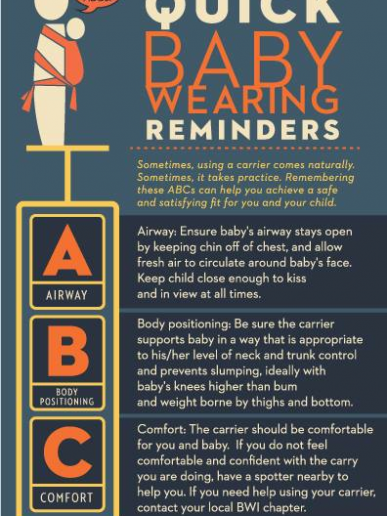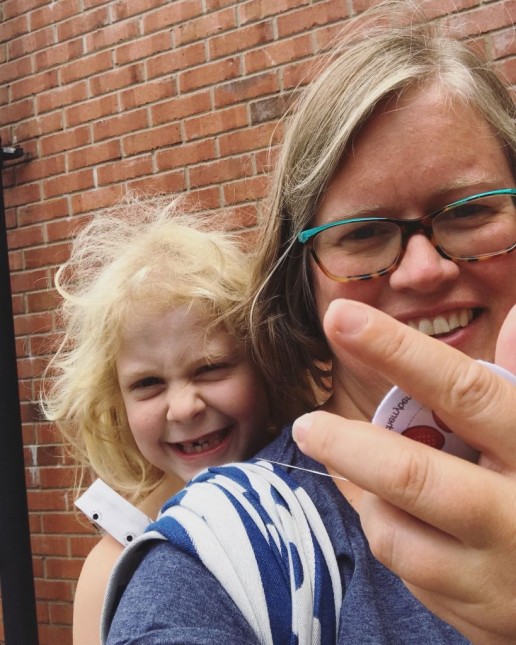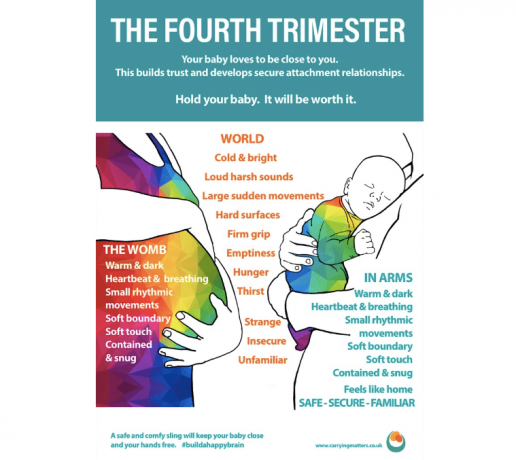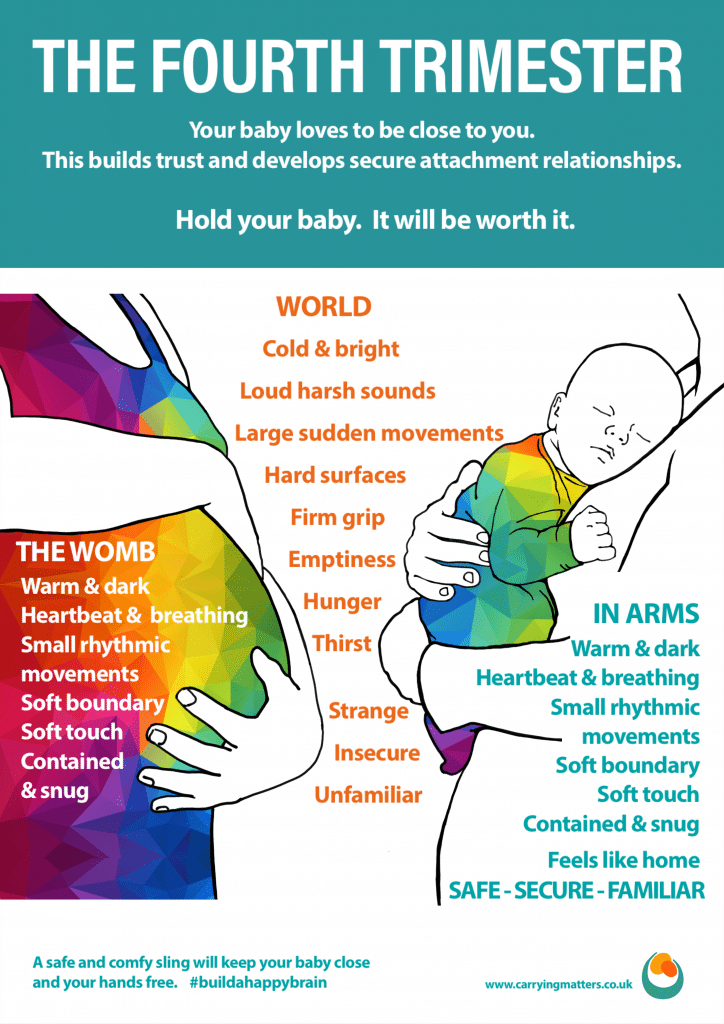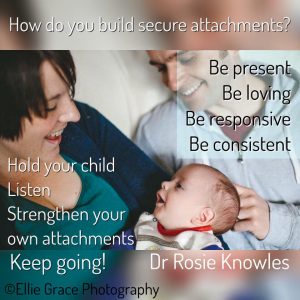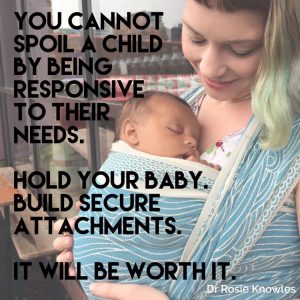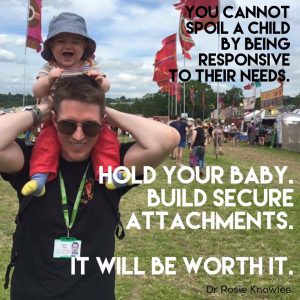Photo tutorial for raising baby up in a too-tall panel carrier to ensure free airflow
This tutorial shows raising baby up inside a panel carrier when the panel is too long, ensuring good airflow and free movement of the head.
This is important, as young babies have a large occiput (the round bone at the back of the skull) and if this is under pressure from behind, the head will tip forwards, pressing baby’s chin onto their chest and downwards into cleavage, which can present an airway risk. The fabric should never come higher than the bottom of baby’s earlobes, so they can move their heads freely. All the head support should come from the upper back part of the panel.
Help! My child cries in the sling
"Help! My child cries in the sling... she seems to hate being put into it..."
This is a frequent worry faced by many parents when they try out a baby carrier for the first time - either the very first sling they have ever used, or when trying to find something more suitable or comfortable for their child's needs as well as their own. I've come across many parents who are concerned that their child unfortunately hates the carrier they have spent money on, or convinced that there is no sling out there that will suit their baby as they always cry when they are put in.
Fear not - it is very common for babies and toddlers to fuss and cry and wriggle in slings, especially when it is a new experience, and my advice to parents in these circumstances is "don't worry, this is very common, you are not alone" and "yes, there are solutions". Crying in slings is common.
So why is it my baby cries as soon as I put her in a sling?
I think the key thing in such situations is to try and understand the experience the child is having - to put yourself in their shoes (or booties!)
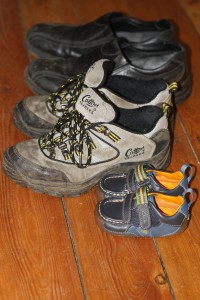
Being able to see things through a baby's eyes can often explain a whole host of issues - babies are small people with feelings just like adults, and they express these sensations in the more limited means they have at their disposal - laughing, wriggling, crying, bouncing, sucking, moaning, yelling, chewing, rooting, leaning, twisting etc. Being able to read and understand your baby's cues is vital to a good relationship and this is one of the benefits of a carrier; parents and carers are usually much more aware and rapidly responsive to a child who is close to their bodies and visible, as opposed to one who is detached and in a pram or a bouncy chair or a play gym etc. So it is good, your baby is protesting, he/she is communicating with you and you are aware of that! Now to meet the need he/she is expressing and thereby solve the problem.. The sling itself is usually not the cause of baby's displeasure.
What does your baby need?
- Is your baby too hot? (it is common to get very warm in a sling quickly. Your own body heat next to a baby's with the extra layers of the sling will bring their temperature right up, and we all know its unpleasant to be sweaty and over-dressed.
- Is your baby thirsty?
- Is your baby hungry? It is always worth making sure your baby is well fed before wyou embark on a new experience - and come armed with bottles, snacks etc to satisfy any hunger. It is usually worth meeting this need rather than ignoring it, as babies won't understand your priorities and will just continue to be upset. If you’re learning how to use the sling with someone, they will be more than happy for you to feed your baby - you are more likely to be able to absorb information when your child is happy. You can talk while feeding and still learn and you will always be able to try the carrier again later! Babies who are breast-fed may need to feed often, and few will refuse food that is offered, even if they've just been fed. Bringing a baby close to a chest full of milk will often create a desire to be fed, or to suck, even if tummies are full.. if you were a baby who could smell milk and were being held in a position where you couldn't reach, it would be maddening, and you might kick, or wriggle, or yell.) If your baby seems to be burrowing down, or chewing their fingers, or shaking his head from side to side, could that be a cue to be fed? Perhaps you can learn to feed in the sling?
- Does your baby have a sore tummy or is he too full of food to tolerate pressure on his tummy, just like an adult after a large meal? A seated sideways carry may be more comfortable.
- Is your baby wet or dirty, and therefore uncomfortable, or are they needing to eliminate? Babies are very aware of their own bodily functions.
- Is your baby tired? Many babies have a fussy period before they go to sleep. You may already be aware of this tendency in your baby when they are falling asleep in bed, in the car, in the pram etc, the sling is no different. A baby may learn that slings often mean sleep and if he doesn't wish to sleep, may protest. A little rocking with baby in sling is usually enough to help them drift off. Sometimes the new experience of trying a sling can be too much stimulation for a weary baby and push him over the edge from tiredness to tantrum, just as it would if you tried to feed him, or change his clothes. A good guide is two new things in a row (so at a sling meet, just try two things!)
- Is your baby in pain? Teething can be uncomfortable; distraction by play is a great tool, and if a baby suddenly has less distraction he may become aware once again of the ache in his jaws. Abdominal distension from constipation or sore genitalia may affect carrying.
- Is your baby responding to how she is being handled? Primitive reflexes like the Moro reflex (that causes the limbs to spread wide and then grasp) or the Tonic Labyrithine Reflex (over-extension, ie back arching due to an unsupported backward-lolling neck) can make babies feel insecure and unwilling to settle into a sling. Lifting and holding your baby securely from both the upper body and below the bottom can help to calm them before moving into a carrier.
- Is your baby responding to how you feel? If you are anxious or irritable while handling your baby, he will pick up on your muscle tone, shaky breathing and jerky movements and become distressed as something feels wrong. Sometimes it is better to just try again later when you are in a better frame of mind.
- Could you and your baby have some difficulties connecting, due to such circumstances as a complex pregnancy or a traumatic birth history (regardless of the objective outcome)? A lot of your unspoken feelings about your unborn baby and how your child arrived in the world can significantly affect bonding later, as can prolonged separation in the first few days or weeks of life. The rate of post-traumatic stress disorder after birth is surprisingly high (up to 9%) and there are several studies that demonstrate that such stress can impair bonding. This could be because of prematurity or illness, it could be due to feelings of guilt that are hard to shake off, even if they aren’t justified. Family dynamics and expectations, especially if they are in conflict with deep biological feelings can also have effects on how babies are handled and responded to. Babies are very sensitive to the feelings of their carers and will react accordingly - your baby’s behaviour and distress could be a signpost to some of your own internal discord and pain. This is where midwives, postnatal doulas and the NHS Afterthoughts services etc can be very helpful indeed in guiding families to find resolution and healing and I do recommend getting some support if you think this may be you.
In summary, if you and your baby are feeling good before you start, you are likely to have a more positive experience, and the more positive associations that are built up, the sooner your baby will begin to trust, enjoy and even ask for the carrier!
What is your baby's personality?
This is an important aspect. I often meet people who almost expect their babies to become utterly still in a sling, and to remain very calm. Well, after all, they're being carried close now, in a giant hug. What's not to love? What's not to be happy about??
Well, not everyone appreciates all-over cuddles, especially if they are not tired, and if they want to be active. This is where understanding your baby's personality may be very useful... imagine you were playing happily and patting a colourful thing in front of you. All of a sudden you are lifted up and wrapped knee to neck in a giant warm bandage, or suddenly put into a carrier, possibly one where you can't see very well. Some babies may love this; and settle down to happy drowsiness (usually because they are ready for cuddles, or are familiar with a well loved sling). Others may enjoy the sudden change of height and scenery and being able to smell their carer. Others may feel annoyed at being taken away from their happy activity, or be cross about not being able to see, or feel too hot, etc and don't appreciate the abrupt change - these babies may strain and bounce and wriggle or cry in protest. Most children I meet are pretty active in some way - and it would be unreasonable to expect them to suddenly change from an active, inquisitive personality into a more docile, still and placid one, especially if the parent also stands strangely still, with their muscles all tense with anxiety about the use of the carrier and if baby will like it. "Mummy doesn't feel right, she's not soft and relaxed - this isn't good."
Remember as well, where is your child in their natural sleep-wake cycle? The more you're able to understand your baby's cues as they express themselves the more likely you are to be able to meet these needs before they feel they have to cry to be heard.
Tips to help you and your baby get used to a sling together
Practice makes perfect
Get confident with a demo doll first. Sling libraries and sling consultants are usually well stocked with weighted demo dolls which will allow you to figure out how to use the sling safely (remember the TICKS guidelines) and confidently. If you are very unsure while using the carrier, your baby will pick up on your nervousness and become unsettled.. this applies to every kind of carrier. This is why I always encourage people who come to me for help to use the dolls first, even if it feels like it will take longer... in the long run it will be more productive as you will have figured out which bits go where and how to tighten that section, so when it comes to trying it with your own child, you will be able to concentrate more on your child and how they are finding it, than simply getting it on. Even a teddy will help if you don't have access to a demo doll. It's the preparation (for example, knowing how to keep a child high on your body while you bring the panel up smoothly, or having a ring sling already set up can make a world of difference to the speed at which you can get the carrier on before your baby gets fed up!) Most babies will only tolerate a few "tries" with a sling, two, three at the most.
- Use your carrier daily, for you both to get used to it, even ten minutes at a time, building up gradually.
Involve your child in the whole process
- If possible, choose a time that baby is likely to be receptive to the sling; if she is fussing as she is experiencing an unmet need, the sling may not be the answer and merely exacerbate her cries.
- If baby is happily playing, do respect that, and don't just snatch her away from her delighted learning. We'd feel a bit put out if someone just removed us from the middle of our day jobs to be cuddled - and for children, play is indeed their "work." Sometimes you may not have a choice (eg school run time!)
- If the time is right, engage your baby during the process, make it fun!
- Tell her what you are doing and make the process of being put into the carrier enjoyable in its own right. A toy, a teether necklace, a song. Rock or sway while you go through each step, and take your time - there is no reason why you can't stop halfway to go and show your baby her reflection in the mirror, for example, before carrying on. Babies have not yet learned how to be patient - they may spot a toy and want it at once - being denied the opportunity to get the toy can be frustrating and lead to wriggling.
Be caring and careful
- Observe how your baby likes to be carried in arms. Does she prefer hip carries? Does he love piggy backs? Try to reproduce this as far as you can. Babies are often "nosy" in the 4-8month period, and ring slings or hip carriers can be a brilliant way to carry a baby to meet their need to be inquisitive! Their preferences will often change as they grow. Try arms out for babies over 4months - freeing the shoulders can make a big difference!
- Check your baby is safe
(keeping his airway open and his breathing unobstructed is vital) - see link for more information on this
- Check that he is comfortable - if something feels wrong or hurts him, he will let you know somehow. Understanding how to create a comfortable position that allows deep relaxation is important. We all shift our positions without thinking during the day (eg recrossing legs, pulling up socks) and it is hard for a baby to do this as easily. We must be caring and careful. So familiarise yourself with the ideal M shape pelvic tuck position (knees above bum with pelvis tilted inwards) which will avoid any strain on the joints and allow a comfortable curve of the spine. Such a shift from a previously "splatted starfish" position to a hammock-shaped seat can really help. Ensure baby can move her legs freely at the knee (make the carrier narrower if needed) and no red marks are developing (raising the knees up can help with this problem). Babies should have free and easy access to their mouth with their hands for sucking or exploring. Check that fabric is not digging into baby's neck (a muslin roll can help here) and that any knots, webbing or buckles are not pressing on baby's body. Ensure baby feels secure, but not restrained or restricted (too tight carriers, or too large carriers, can pose problems of their own).
Keep your baby occupied!
Remember that your baby still wants to experience the world even while carried, as they do when playing on your lap or on the floor. Help them to be able to see a little, in a way that is appropriate for their age and still respectful of growing spines and hips. A carrier that has straps or fabric that comes close to the face may be irritating (do remember that babies grow taller, and many carriers can be adjusted to ensure faces and heads not obscured). Make sure that there is some activity going on - we all know about the sway we do to settle babies when carried in arms, and how often we shift them around, or the rocking/pushing of the pram - this gives a child some sensory input, rather than remaining still. I often encourage parents to go for a short walk round the block when they have just put a sling on with their baby - the motion and movement to get out of the house and the fresh air and change of scenery usually works wonders and parents come back with happier babies. Of course, once the parent is standing still again, and baby is bored with the reduced activity, he will protest!
Keep going!
Learning a new skill can take a little time and effort... both for you and for your baby. New experiences need to be absorbed and processed.. and every day is a new day, we all have off days, babies as well as their parents. If your baby cries in the sling, try using your carrier a little bit every day, for walks or participating in safe but engaging activities.. and bit by bit see if it gets easier and your baby becomes happier. The more relaxed and confident you are, the more your baby will respond to that (just like anything in life.) Don't force it, take your cue from your baby! If after a good go, things still don't feel right, try another one from your local sling library, and ask your friendly consultant/peer supporter to check your positioning - this is the best way to work out what carrier will suit each unique parent-child combination, and will save you money in the long run (you won't buy a carrier that doesn't work well!)
There are so many great things for you and your baby to gain from being able to use a sling - it is worth a little perseverance to get your carrying journey off to a great start, and hopefully this will be the beginning of a long and happy shared experience together!
Stretchy Wrap bump wrapping photo tutorial
Here is a simple stretchy bump wrapping photo tutorial that may help to relieve some of the discomfort of the last few weeks of pregnancy, using a long stretchy wrap that has been tightened gently around the body.
Ideally, we would all have good core function and structural stability before we enter the later stages of pregnancy, making the need for external support less necessary. A good women’s health practitioner or chiropractor would be able to advise on how to care for your body during pregnancy and deal with issues such as symphysis pubis dysfunction or sacro-iliac joint pain.
This “bump wrapping” technique has been used by many cultures the world over to ease some of the discomforts of very late pregnancy and you may find it helpful. We would recommend using bump wrapping only in the last few weeks of pregnancy, as a brief reliever at the end of the day, for example. It is not a substitute for good core strength and excessive or prolonged use will not be helpful in the long run. Any chronic or recurrent issues should be seen by a health care practitioner, such as a women’s health physiotherapist, or an osteopath or chiropractor with the relevant expertise.
Please see our main blog post for more information from Sara, an osteopath specialising in helping pregnant women.
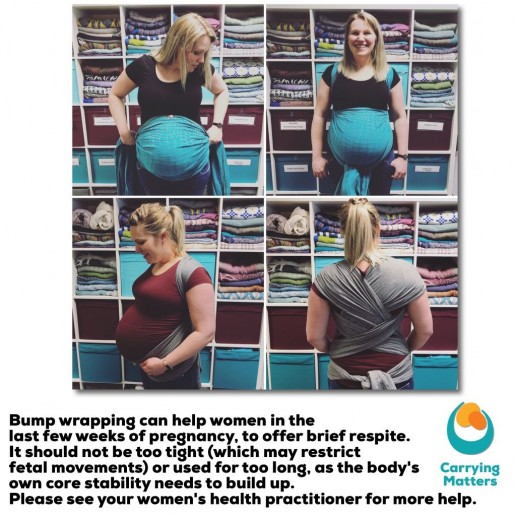
Woven Bump wrapping photo tutorial
Here is a simple woven bump wrapping photo tutorial that may help to relieve some of the discomfort of late pregnancy, using a long woven wrap that has been tightened gently around the body.
Ideally, we would all have good core function and structural stability before we enter the later stages of pregnancy, making the need for external support less necessary. A good women’s health practitioner or chiropractor would be able to advise on how to care for your body during pregnancy and deal with issues such as symphysis pubis dysfunction or sacro-iliac joint pain.
This “bump wrapping” technique has been used by many cultures the world over to ease some of the discomforts of very late pregnancy and you may find it helpful. We would recommend using bump wrapping only in the last few weeks of pregnancy, as a brief reliever at the end of the day, for example. It is not a substitute for good core strength and excessive or prolonged use will not be helpful in the long run. It should not be too tight, to avoid restricting fetal movements.
Any chronic or recurrent issues should be seen by a health care practitioner, such as a women’s health physiotherapist, or an osteopath or chiropractor with the relevant expertise.
Please see our main blog post for more information from Sara, an osteopath specialising in helping pregnant women.

Babywearing Training
Do you love babywearing and want to know more about it, or be able to support others with their sling use? Then one of my courses could be just what you need!
- Do you want to understand more about why sling and carrier use is such an important tool for new families, and be able to be an effective advocate for their use?
- Do you want a good grounding in basic babywearing safety across a range of circumstances and an introduction to the major types of sling and how to use them well?
- Do you want to support families with their carriers?
- Are you thinking about setting up a sling library service or a specialist baby class (yoga, forest school etc)
- Do you want become a consultant, able to work with more complex situations?
- Are you a NHS worker planning to use carriers for babies or children in specific settings (eg neonatal physiotherapist or occupational therapist?)
- Are you a health or social care professional (eg a council worker, health visitor, infant feeding worker) wanting to know more about safe sling use and how to advise parents and signpost appropriately?
I offer babywearing safety courses as well as in depth peer supporter and consultant training, please see below for my courses. Bespoke courses can be created on request.
I also work with other trainers in different parts of the country, who can offer peer supporter courses. Please see here for more information.
If you would like to become a trainer yourself, please contact me directly.
Babywearing theory and sling/carrier safety – online course, £49
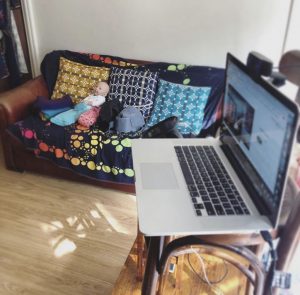
This is open to everyone, and can be completed at your leisure. There are short tests of your knowledge as you proceed through the course and a final assessment to complete the course for a certificate of online learning.
- This will suit many people who wish to enhance their knowledge and understanding, become evidence-based babywearing advocates, be able to signpost to local libraries with more confidence, and are not planning to offer in-person support to families on a regular basis.
- This course is not timed, and can be done at your own schedule and to your own pace.
- Please be aware that this course is not a Peer Supporter or Consultancy course and the certificate cannot be presented as such.
- This course is not sufficient on its own for anyone planning to offer any form of movement classes with babies in slings.
Structure of the course
- Why Carrying Matters – the science.
- Introduction to Basic Babywearing Safety.
- The Different Types of Slings And How To Use Them.
- Assessment Module (to confirm learning)
Sling and Carrier safety and signposting course for organisations working with parents – hybrid online and practical course, TBC
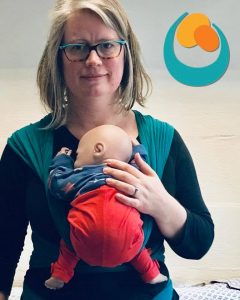
This course is particularly suitable for organisations who work with antenatal and postnatal families, wishing to be able to offer basic safety advice and are not planning to offer in-person one to one support to families with their own slings.
- Please be aware that this course is not a Peer Supporter or Consultancy course and the certificate cannot be presented as such.
- This course is not sufficient on its own for anyone planning to offer any form of movement classes with babies in slings.
Structure of the hybrid course
- Online – Why Carrying Matters – the science about why using slings is so beneficial for families
- Online – Basic Babywearing Safety
- Online – The Different Types of Slings
- Online – Assessment Module (to confirm learning)
- Half day in person training with a Carrying Matters trainer to consolidate learning
- Assessment MCQ to assess competence, if passed, will be issued with a certificate of learning.
 Peer Supporter Course, £129 per person, half a day online learning, half a day practical learning (in person or online)
Peer Supporter Course, £129 per person, half a day online learning, half a day practical learning (in person or online)
The Peer Supporter course is a combination of online learning and a practical training session, either online via Zoom, or in person.
The online learning covers the theory of babywearing, basic safety, an overview of the main types of carriers and how to use them, the role of the peer supporter, and a little about special circumstances. It is more in depth than the simple theory/safety course.
The practical session focuses on actively supporting new parents with hands-on-help, providing them with support with fitting and troubleshooting. Babes in arms are welcome as we recognise that babies need their parents! We would encourage you to consider the impact that older, more mobile children and toddlers can have on your and others’ learning.
More information about the course and the equipment can be found here.
Satisfactory completion of this course and the assessment will generate a certificate of competence as a Babywearing Peer Supporter.
Structure of the Peer Supporter Practical session
- Building and assessing skills in using the main types of carrier.
- Learning and practising how to support others and troubleshoot effectively.
- Opportunities for discussion with Rosie and fellow students.
- Assessment Module to ensure receipt of information and ensure the high standards of training are met.
If you have done the online theory/safety course in the past and wish to upgrade to Peer Supporter training, please contact Rosie.
Reduced cost places are available for certain priority groups, read more about that here and how to apply.
 Peer Supporter Course for HCPs, £129 per person, half a day online learning, half a day practical learning (in person or online)
Peer Supporter Course for HCPs, £129 per person, half a day online learning, half a day practical learning (in person or online)
The Peer Supporter course is a combination of online learning and a practical training session, usually online via Zoom or MS Teams for health care professionals around the UK.
The online learning covers the theory of babywearing, basic safety, an overview of the main types of carriers and how to use them, the role of the peer supporter, and a little about special circumstances. It has a greater focus on newborns or children with extra needs in health care settings.
The practical session focuses on actively supporting new parents with hands-on-help, providing them with support with fitting and troubleshooting. and can be tailored to work with particular carriers.
Bespoke courses for groups are available.
- Satisfactory completion of this course and the assessment will generate a certificate of competence as a Babywearing Peer Supporter.
Babywearing Consultancy course
I love offering consultancy courses, equipping people with the skills they need to support parents and carers with their children – the impact of such people can be life changing for families. As Kiri and I worked with our 2022-2023 cohorts, two things became clear – firstly that people really value the face-to-face element of training, especially with the more complex situations we are more likely to encounter as consultants, and secondly, that there is a huge amount of knowledge being imparted in a very short space of time, which can be challenging to absorb and then put into practice independently.
With that in mind, in 2024 we changed our format to be a longer course that allows people the time they need to learn as they go, and apply their new knowledge, develop questions and build relationships while still part of the course, and kept the face-to-face aspect in a single weekend of in-person training.
The course has three sections.
- A comprehensive online theory section. This covers all aspects of babywearing safety and the basics of carrier use, the history of babywearing, the science behind close contact, how to develop consulting skills, and much more. This is in a modular format that can be done at your own pace before the practical sessions, and will take around 12 hours of learning time.
- A series of 5 live 2-3hr Zoom sessions where we begin learning and practising how to use the major carrier types in depth, how to adapt them to individual needs, as well as working on communication and exploring common scenarios. Each week has a different theme and you will be encouraged to put your skills to use before the next session, to allow for real-time practice and personalised feedback.
- A weekend of in-person learning with me and Kiri in Sheffield, where we work on complex situations, disabilities, and the ‘soft skills’ that are so key to effective consultations and satisfying encounters (as well as what to do when things are not working as you had hoped!). This is the culmination of the course where we bring everything together.
All our trainees become part of their own cohort for discussions and feedback, as well as joining the Carrying Matters educator groups (and the UK professional groups) for ongoing support.
The course costs £600, and payment plans are available. Please do get in touch if you have any queries. Further reading here.
Why train with me?
I am a Carrying Advocacy educator and trainer, and am well known for the evidence base and scientific focus of my training, as well as my ability to demonstrate clearly and simply, and explain concepts simply and engagingly. My interest is in supporting new families with babywearing, due to the enormous value this skill can add to their wellbeing and their long term health and my goal is to see this become available to every antenatal and postnatal family, via educated advocates!
I have trained hundreds of people and educated many more over the last ten years. These range from interested parents who want to volunteer or help their own friends, massage therapists, early years providers, health care professionals (health visitors, midwives, doulas etc) and those who want to set up their own local sling libraries and become consultants.
Feedback
I’d highly recommend any enthusiast to attend this course. I found it thoroughly enjoyable and look forward to being able to use this new knowledge to help more parents discover the benefits of babywearing, as I have.
R.T.
Thank you for such a truly amazing course I came away a much more confident person and I learnt a lot from the course. I have been raving about it since.
Z.S.
It was a fantastic course! I learnt so much and came away feeling really confident. I am so looking forward to putting my new knowledge and skills in to action.
R.E.
I really enjoyed it. I have learnt a lot. I liked the way it was structured and the friendly manner things were taught in. I felt supported throughout and never felt stupid about lack of knowledge which was great.
It made me eager to learn much more.
A.E.
“Your course is incredible! Far, far more than a course about babywearing. There is neurology, cognitive development, sociology, psychology and attachment theory (so far), all woven together with the theme of carrying and the early environment. I am absolutely loving working my way through. These are all the themes I am so interested in.”
C.S.
Rosie you are an inspirational teacher, it was a pleasure to have met you and learned from your wealth of experience!
K.M.
“I thoroughly enjoyed Rosie’s online theory course on babywearing. It was easy to use and navigate online. As well as the written word, there were informative videos and links to other articles to read covering many varieties of slings and carriers, how to wear them and troubleshooting. The course started by talking through why carrying matters and the science behind it, all so important to know and understand when helping new parents. An introduction to babywearing safety and the role of the peer supporter are also included and have the perfect level of detail. Overall I found the course very informative and easy to break down into manageable sections to work through at my own time. I feel fully informed and now understand why carrying matters, the different options available and the importance of safety when carrying. I feel much better informed to be able to support parents with their carrying journey.”
C.C
“The detail in the course was very helpful and interesting- I think the evidence-base and history of baby wearing is so important, particularly as a health professional so we can inform parents fully about why it is a good practice that we should encourage and why society can cause us to have conflicting perceptions.”
R.C.
What a wonderful course! Packed full of information and learning. Rosie knows a staggering amount and is so enthusiastic and inspiring.
J.T.
Rosie was fab – really brilliant. I remain in awe of her skill in teaching and working with new mums sensitively yet safely.
E.S.
I’d highly recommend any enthusiast to attend this course. I found it thoroughly enjoyable and look forward to being able to use this new knowledge to help more parents discover the benefits of babywearing, as I have.
Thank you for such a truly amazing course I came away a much more confident person and I learnt a lot from the course. I have been raving about it since.
It was a fantastic course! I learnt so much and came away feeling really confident. I am so looking forward to putting my new knowledge and skills in to action.
I really enjoyed it. I have learnt a lot. I liked the way it was structured and the friendly manner things were taught in. I felt supported throughout and never felt stupid about lack of knowledge which was great. It made me eager to learn much more.
“Your course is incredible! Far, far more than a course about babywearing. There is neurology, cognitive development, sociology, psychology and attachment theory (so far), all woven together with the theme of carrying and the early environment. I am absolutely loving working my way through. These are all the themes I am so interested in.”
Rosie you are an inspirational teacher, it was a pleasure to have met you and learned from your wealth of experience!
“I thoroughly enjoyed Rosie’s online theory course on babywearing. It was easy to use and navigate online. As well as the written word, there were informative videos and links to other articles to read covering many varieties of slings and carriers, how to wear them and troubleshooting. The course started by talking through why carrying matters and the science behind it, all so important to know and understand when helping new parents. An introduction to babywearing safety and the role of the peer supporter are also included and have the perfect level of detail. Overall I found the course very informative and easy to break down into manageable sections to work through at my own time. I feel fully informed and now understand why carrying matters, the different options available and the importance of safety when carrying. I feel much better informed to be able to support parents with their carrying journey.”
“The detail in the course was very helpful and interesting- I think the evidence-base and history of baby wearing is so important, particularly as a health professional so we can inform parents fully about why it is a good practice that we should encourage and why society can cause us to have conflicting perceptions.”
What a wonderful course! Packed full of information and learning. Rosie knows a staggering amount and is so enthusiastic and inspiring.
Rosie was fab – really brilliant. I remain in awe of her skill in teaching and working with new mums sensitively yet safely.
FAQ
Can I just do the online theory and safety course?
Yes, this will generate a certificate of competence in babywearing theory and safety, which may be all you need. You will have a good grounding in why babywearing is so useful, based in evidence, a solid understanding of how to keep a baby safe in the major types of sling and be able to advocate and signpost to further resources. This is not a peer supporter or consultancy course.
I want to support new parents to choose a good sling, and become confident in putting their slings on, or set up a sling library. What courses do I need?
You will need the Peer Supporter Course.
I want to offer classes for new parents and their babies with slings as part of the class. Is the online theory course enough?
No. You must do the Peer Supporter training. The online theory course will not be enough on its own, as hands-on skills and careful planning of classes are needed. Adding any movement with a sling beyond walking increases the potential for harm. Babies and their caregivers’ wellbeing should be the primary concern for such classes, and they should not be placed at risk by inadequate training.
Can I have a practical session tailored to the specific need of my group (eg neonatal nurses, health visitors or for dance classes, etc?)
Absolutely, you can do the online theory and safety course and then have your own group practical session with me, please get in touch to discuss your needs. Please be aware that I am a working GP and can only offer a certain number of practical sessions per year.
Do I need insurance?
Those who attend this course, complete the post-course assessment and receive their certificate of completion are eligible for insurance from several providers, such as BGC, Therapist, and more.
Dance and exercise classes with slings
Please read this first if you are considering setting up one of these classes. The safety of child and parent is paramount at all times and there is simply too much to cover when the class instructor is not already very familiar with slings and aware of the risks involved (this is more than just being aware of the “TICKS” guidelines). If you want to discuss whether you are suitable for entry on this course please email me before you book. I reserve the right to refuse training.
“I really enjoyed trying different carriers. I found the trouble shooting sections particularly interesting and fun. I learnt a lot and feel more confident with all carriers and especially with how to wrap a new born.
I really loved it and now want to do the consultant training even more. Rosie was clearly very enthusiastic and dedicated and made everything so interesting. She was pretty inspiring.”
“Everything I had hoped for was met, I feel like a peer supporter now, not just someone who loves slings!”
“Rosie was born to teach people. Simply fantastic in the way information was relayed. Would highly recommend.”
“The whole day was so good! A key element was the ability to see and try so many different types of slings and to have time to go through basic principles regarding how to use them all. The role play aspects where we were able to troubleshoot carrier problems was also very useful.”
“Hi Rosie, I couldn’t go to bed without sending you a note to say a huge thank you for the course today. I’ve never felt more included and welcome and I’m so thrilled I came along. Thank you for your hospitality and brilliant teaching, I’m raving about babywearing to my husband and cannot wait to volunteer at a meet soon.”
“I loved the content of the day, the discussions, playing with different slings, learning new ways of slinging, wrapping etc. The course was well run, well organised and I felt empowered to speak, share and question.”
“I feel much more confident in my knowledge of both the benefits of babywearing, and how to go about enabling parents.”
“I really enjoyed meeting other like minded people. I liked the theory of babywearing as it related closely to the work I do as Breastfeeding Lead in the NHS. I enjoyed trying all the different slings and carriers and understanding in what situations they would be used.”
“My personal learning aims were met, it exceeded my expectations. I found the course was extremely enjoyable and covered so much subject matter but was not overwhelming. My aims were well and truly met. I now believe I could give a new babywearer good/correct advice and help in ways I was unsure about prior to the course.”
“Having someone with your experience and knowledge available all day to ask questions and watch demo was incredible. I really enjoyed the contextual and historical information about Babywearing and what led us all into that room that day. It put everything into the ‘bigger picture’ and made me feel such a part of the huge Babywearing community. Having such a massive amount of slings in the room to try and compare was utterly invaluable – such a rare opportunity. I thought the balance between practical and theory was absolutely spot on. As someone who’s very interested in the sociopolitical aspects of Babywearing I was really pleased to see this covered in the course and really appreciated that you placed Babywearing so firmly in this context during the day.”
“The course really opened my eyes to consider the needs of individuals and how essential it is to be inclusive and approachable and gave me the tools to do this confidently (especially regarding narrow base carriers). It was useful to be shown how to exaggerate movements and words when teaching and to have the opportunity to practice this. Rosie’s enthusiasm was infectious and made the whole day very engaging. The size of the group worked well and I especially enjoyed how well we all got on.”
Educational Resources
This page contains various resources that may be useful for education and supporting others. Leaflets, posters and postcard packs can be purchased. Images and PDFs can be downloaded free of charge by clicking on the photos. Please ensure you credit me (Dr Rosie Knowles) if you use them.
Safety Resources
- The 4 Key areas webpage can be found here – this has links to translations into other languages.
- The Carrier Height webpage is here – the image can be found lower down on the page.
Click on the image to download a PDF, or order a pack of high quality printed leaflets using the button below.
Click on the image to download a PDF, or order a pack of high quality printed leaflets using the button below.
Click on the image to download a PDF, or order a pack of glossy postcards or posters using the button below.
Click on the image to download a PDF, or order a pack of glossy postcards or posters using the button below.
Click on the image to download a PDF, or order a pack of glossy postcards or posters using the button below.
Click on the image to download a PDF, or order a pack of glossy postcards or posters using the button below.
Click on the image below to download a PDF, or order A3 posters using the button below.
Click on the image to download a PDF, or order A3 posters using the button below.
Click on the image to download a PDF, or order A3 posters using the button below.
Click on the image to download a PDF, or order A3 posters using the button below.
Click on the image to download a PDF, or order a pack of posters using the button below.
Click on the image to download a PDF, or order a pack of posters using the button below.
Read Rosie’s well loved Why Babywearing Matters book here, published by Pinter and Martin.
Read Rosie’s well loved Why Babywearing Matters book here, translated into Polish by Lenny Lamb.
Snowsuits, Scarves, Slings and Safety - Carrying in the Cold
Autumn and winter can be a wonderful time of year, with frosty mornings and chilly walks, the first snowfall, and a little child nestled cosily up to you. Fresh air is good for the soul, and exercise and changes of scenery can make a big difference to family life. You don't need to be afraid of wintry weather, in fact, a baby carrier can help you go places!
It is important to consider safety in all things, and dressing warmly for winter while using a sling/carrier is no exception. Snowsuits may be cute and warm but they need to be used carefully.
When the weather turns chilly, or even icy, every caring parent’s mind turns to how to keep their baby warm in the cold air. Out come the snuggly snowsuits and the hooded jackets, out come the warm cosy scarves and thick cardigans, all aimed to keep you and baby toasty warm. At sling library sessions I can often be found encouraging parents to undress their babies, and often themselves! But why? Surely warmth is important?
Indeed it is, and it is good to be aware of your child’s needs. But there is often still a question about the best way to keep warm when you are using a sling… are the snuggly snowsuits really the best option? Are they safe to use, especially with the current advice about avoiding thick coats in car seats? (see the link at the bottom).
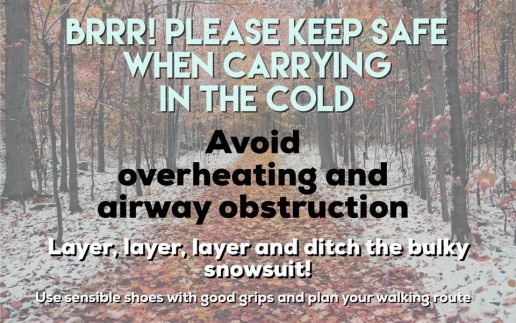
I see a lot of parents with small babies (under four months) in snowsuits or thick jackets who are then settled into a carrier, be it a stretchy or woven wrap or a meh dai or a buckle carrier. Problems can arise at this point; baby is often too warm, and may be rather sleepy as a result, or irritable, and the parent may be finding the carrier uncomfortable. Babies under 4 months are at greatest risk of difficulties due to their relative smallness weakness; they do not have strong and sustained head, back and torso control, so are more likely to run into problems. Older babies and toddlers are very different!
Let’s look at some of the major factors to consider when using a carrier in the cold.
1) Be aware of OVERHEATING
Too many thick snuggly layers can be a risk of overheating. Babies are by nature warm little creatures (carrying them can feel like having a delightful wriggly hot water bottle on your front) and it is their extremities and their heads that need protecting much more than their middles. They are not yet able to regulate their own temperatures in the way that adults can (which is why skin to skin contact from an adult for a feverish or cold child can be so very useful) so being close to your body will rapidly warm a child up anyway. As you walk you will warm up, and your extra heat will warm up the child on your front even more.
Being too hot is not good for babies; it makes them sleepy and overbundling a sleeping baby is a risk for SIDS (sudden infant death syndrome). It makes sense to avoid this overheating in slings just as much when baby is sleeping in a bed or a car seat. Furthermore, being too bundled up reduces their ability to sweat (the drops of sweat need to be able to evaporate to carry heat away) which means even older children who can regulate their temperature better will also struggle with being too hot. Hot babies are at significant risk; it is relatively easy to add extra layers for warmth if you misjudge slightly and to remove them when you come in out of the cold.
.
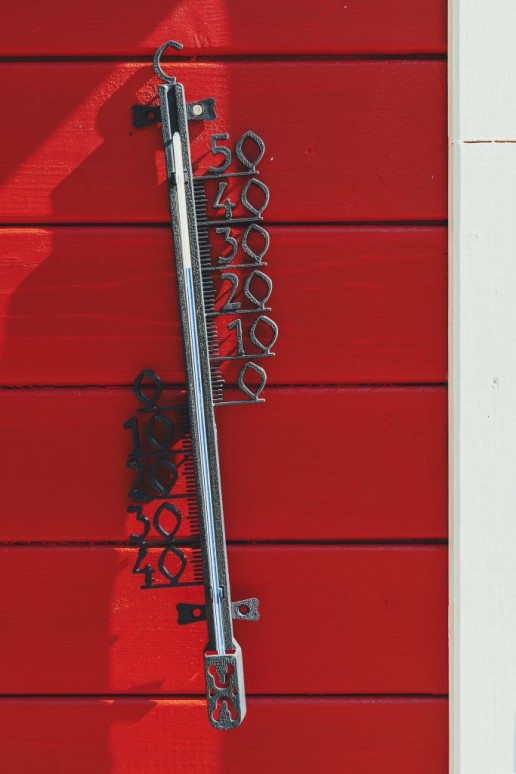
2) Be aware of AIRWAY
Sometimes the weight of baby inside the snowsuit can mean they sink down inside it, due to gravity, and end up with their faces buried inside the body of the snowsuit. This may pose a risk to airway and breathing; the same goes for hooded jackets or thick cardigans that can “ride up” the back of the carrier.
Too much fabric around the chest and upper body will also make it hard to achieve a fully supported back and a tight carry. This may increase the risk of too much space between baby’s head and your chest, allowing his chest to curl and compress and his heavy head to slump forwards, potentially compressing his airway, or burying his face into fluffy fabric, reducing airflow. Thick snowsuits really can be a significant risk.
Always ensure good airflow. Be aware of your own clothing too; a cowl or a scarf may prove problematic if your baby snuggles his face into the fabric, reducing free airflow. This is more of a risk with smaller babies than in those who have head control and are able to move themselves independently.
Make sure your baby’s face is not obscured by scarves or fabric that could be problematic if they fall asleep.
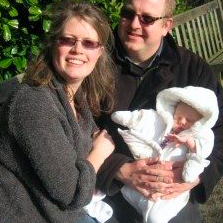
This little boy is too small for his snowsuit; if he was placed inside a sling his face would disappear into the fluffiness.
3) Be aware of POSITION
Increased bulk can affect positioning considerably. It is hard for joints to bend easily in thick, stiff trousers or multiple layers of clothing, so the M shape with bent knees higher than bottom that encourages healthy hips and protects the natural curve of the spine into a J shape can be hard to achieve. Baby may end up being “starfished” into a carrier with a hyperextended posture, rather than being comfortably seated.

Baby will feel heavier as he is not resting against the parent/carer’s body in the same way, and the weight distribution will change.
Too much bulk around the top may also affect the support to baby’s upper body, meaning that baby’s weight is pulling back away from your shoulders, rather than resting on your chest, and may be more uncomfortable.
Too much padding around the nappy region (especially in those babies wearing cloth nappies) could cause a reduction of blood flow to the lower limbs.
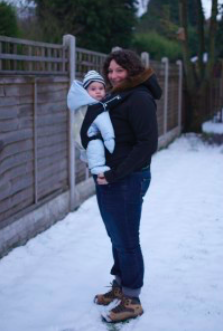
Baby above, has been straightened into a starfishing shape as the snowsuit is preventing his hips and knees from bending. however baby below is in the M shape.
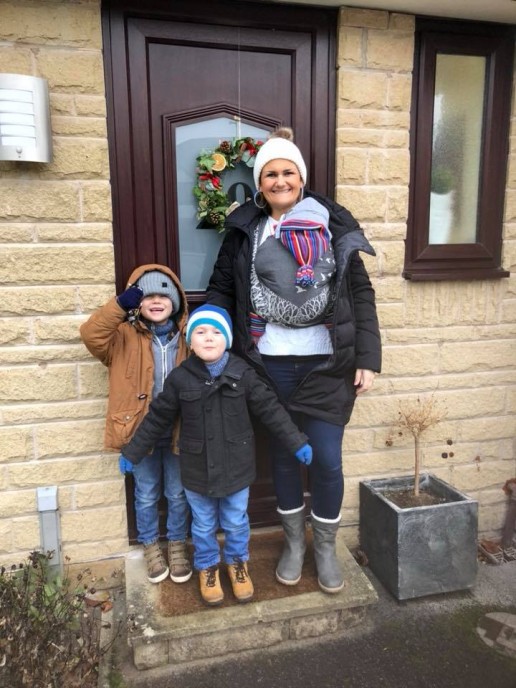
OK, so this is good to know. But it’s cold out there! My baby needs to be warm, what can I do?!
Here are some suggestions how to ensure your chilly weather carrying is safe and still snuggly warm.
If you need to go out in windy and cold conditions, or snow storms, your small baby will be warmest and best protected close to you on your front, here you can shield them from the wind and horizontal snow flurries easily.
Back carries for older children may be easier for you to see your feet as you go but be alert to their experience and ensure they are well protected. Carriers that keep children close to your body will be warmer and less likely to make you feel off balance as you walk, compared to framed backpack carriers worn high on the back; these will also be very cold for children as they are held away from body heat and more exposed to wind chill.
1) LAYER LAYER LAYER – carrying under coats
This is key to virtually all carrying, as the sling is in itself a layer of clothing, and sometimes more than one, depending on its type. A stretchy wrap is three layers, and some are thicker than others. Some buckle carriers are double layer panels, some are three. Every parent/child combination have their own micro-climate too, so what feels right for one family may be different for another.
In hot weather, you need as few as you can manage safely, whereas in cold weather you need more layers. Layers trap air in between them, so can often be more effective at providing warmth than one or two thick items of clothing, while still allowing flexibility.
Thin light all-in-one fleece suits are warm, while still being breathable and allowing good joint movement for positioning. It may be worth considering a size up to protect little toes with the riding up you get with a sling, however, too large a fleece could mean too much fabric around the face and neck. Layer up with vests and onesies and cardigans and leggings and so on, rather than using a very padded or furry inflexible snowsuit, you will be surprised how warm babies can get!
It is best, if possible, to keep baby as close to you as you can, and add layers on over the top. These layers can be undone/removed easily if baby is getting too hot (flushed, very warm chest skin, sweating, unexpectedly sleeping, for example), or if you go inside into a warm shop from a cold outside.
Wearing a large (maternity or oversized) coat which you can then wrap around your baby on the front will add warmth, as will a mac in rainy weather.
If you are creative, you could knit yourself a panel insert which would button onto your favourite button coat, making it wider to fit your baby and the sling inside. You can do the same with a zip insert (check before you buy that the zip insert fits onto your own zip). If you are innovative, you can use a large oversize hoodie or cardigan with a very big neck or a zip that can be undone to go over both of you, or wear an oversized coat backwards if you can get someone else to do up the zip. Others may use a large shawl to wrap around themselves, or a home-made fleece poncho.
There are many babywearing coats or ponchos or vests and other items of clothing on the market which have been specifically designed for this, such as the Mamalila, Lenny Lamb, Zoli, Wombat, Momawo, Liliputi coat ranges (among many others), Boba/Lenny Lamb/Angelwings hoodies/fleece vests, to name just a few, and many are suitable for back carrying.
Some can be expensive; for many they are invaluable especially if they are used frequently for back carrying (many maternity coats or extender panels do not allow back carrying) and some are stylish enough to be worn as normal coats to make them worth the outlay. Some will have hoods for both parent and baby, some won’t – it is worth doing your homework and trying a few before you splash out.
There are also some babywearing covers, similar to pushchair covers, that can just go over baby and sling but not parent, which may be useful if the parent prefers less warmth (such as Bundle Bean or Isara).
In rainy weather, some will use large anoraks over both baby and parent. There are several waterproof ponchos or covers on the market which can go over the sling on the top and umbrellas are very useful. Some creative folks have even threaded the arms of cross strap buckle carriers through a child’s waterproof anorak to cover over the panel!
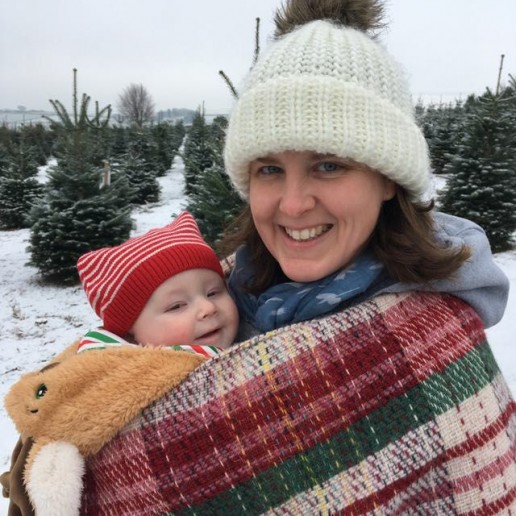

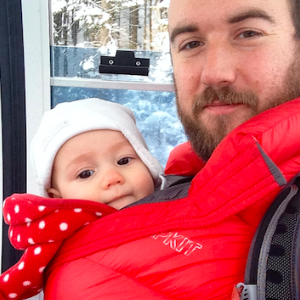
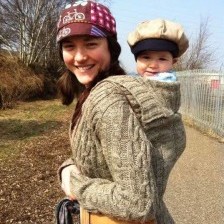
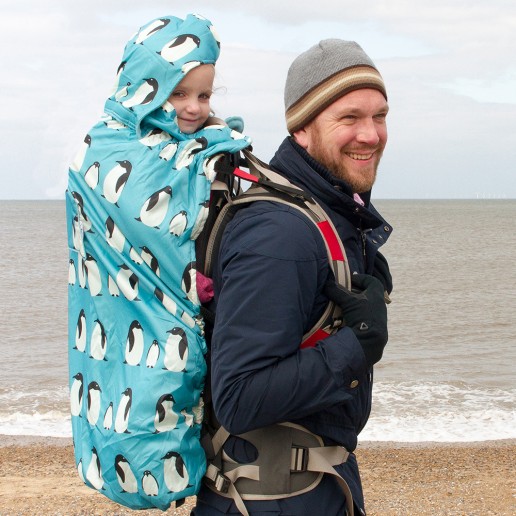
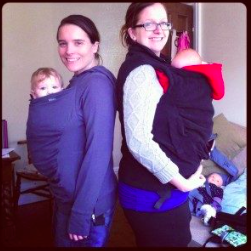
2) PROTECT EXTREMITIES
So if your baby’s body is nice and warm, heads and limbs need to be kept warm too.
This is where things like baby leggings, tights and socks can be very useful indeed, layering up over the feet. Some people find boots helpful as well, such as Stonz or Thinsulate boots (varying price ranges) or wooly booties that can be tied gently on to avoid falling off. Some fleece onesies have feet that can be folded over to make a closed foot. Feet can get much colder than hands as they are harder to tuck in near the warm central core.
Heads can be kept warm with hats…(of which there are many gorgeous options). Some opt for balaclavas with neck covers and various hoods to keep necks warm and prevent removal!
Hands can be kept warm with gloves with ribbons sewn in to stop them from falling off, or socks worn on the hands. Many fleece onesies have sleeves that can be folded over hands.
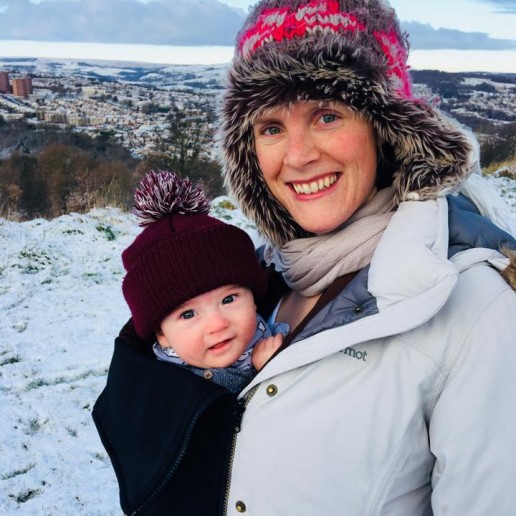
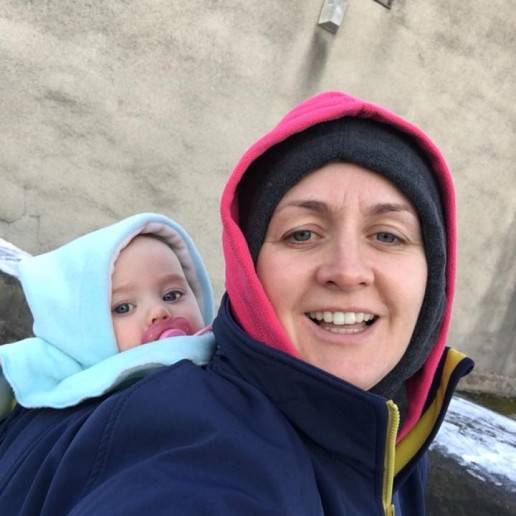
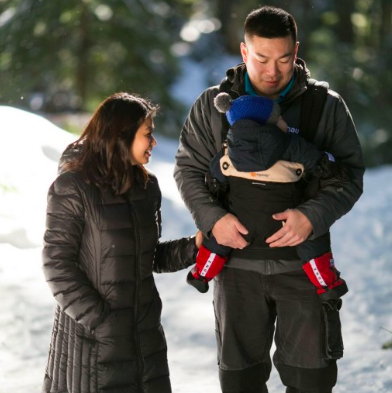
3) MANAGING CARRYING OVER COATS
This tends to work better for older babies or toddlers who want to be up and down all the time, and can work well in some circumstances, depending on the coat, the carrier and if you have anyone to help you. It can be hard to get a sling snug over the top of a bulky or slippery coat, and hard to get a snug fit on the back without help, but for many this works well.
Taking some care when planning the coat you use will make a big difference, (one that is thin and grippy, for example may be easier to work with, and hoods may get in the way of unobstructed breathing). Selecting the sling you use matters too; what you choose for normal use for maximum comfort may prove too complex over a coat. Pick one that is easily adjustable, and easy to get on and off.
This style of carrying over coats on the back may be much more convenient for toddlers who prefer to be able to get up and down again in quick succession. They are more likely to get cold on your back as they cannot snuggle into your body heat in the same way, so will need to be much more warmly dressed than a smaller baby on the front. This is especially true for framed carriers that hold children high up and separate. These children are not at the same risk of slumping over inside over-large suits and ending up with an obstructed airway, and as they are outside your coat, they will get cold. Snowsuits (that fit and are still flexible) can be an excellent solution here, as can waterproofs over coats and snuggly trousers.
Hands and feet will get a lot colder with this type of carrying, so make sure you are prepared.
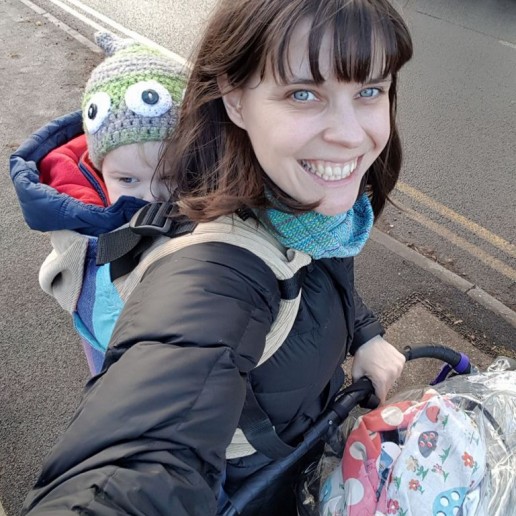
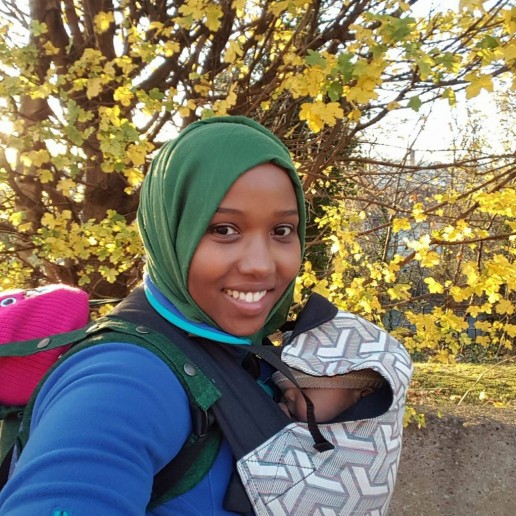
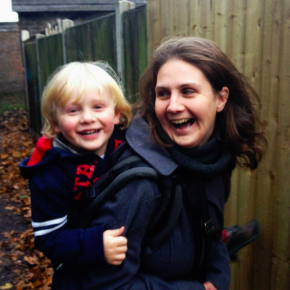
CARRYING IN SLIPPERY WEATHER
It is fantastic to be able to explore in freedom with your child in all weathers. But what about, even if you have the choice of sling and clothing right, the ground is icy and slippery?
CHOOSE SENSIBLE FOOTWEAR!
If carrying in the snow and ice, slip-on ice gripping covers (eg Yaktrax or other brands) that can go over shoes and boots can be enormously useful to prevent slipping… and if you do slip, your baby will be much safer in the sling than she would be loose in arms. Some metal grippers may not work well on mixed ground, as they may slide on smooth surfaces and can be hard to remove quickly, so have a good look at a few types and where you will need to use them before you pick one. It can be hard to remove them with a baby on your front, so plan ahead!
Good boots with grippy soles designed for all terrains may be worth investing in. Some families have used very large knitted socks over their shoes for grippiness over snow and ice when they know there are also stone stairs etc on the school run and they don’t want to go flying.
Some people recommend front carrying more in slippery weather, as if you do fall, you can use your hands to break your fall and protect your child more easily than if you fall backwards. Some people prefer not to carry at all and to use a buggy! Use whatever tool works best for your circumstances.
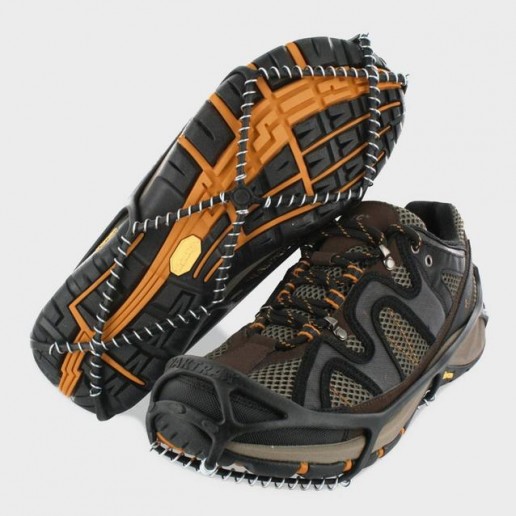
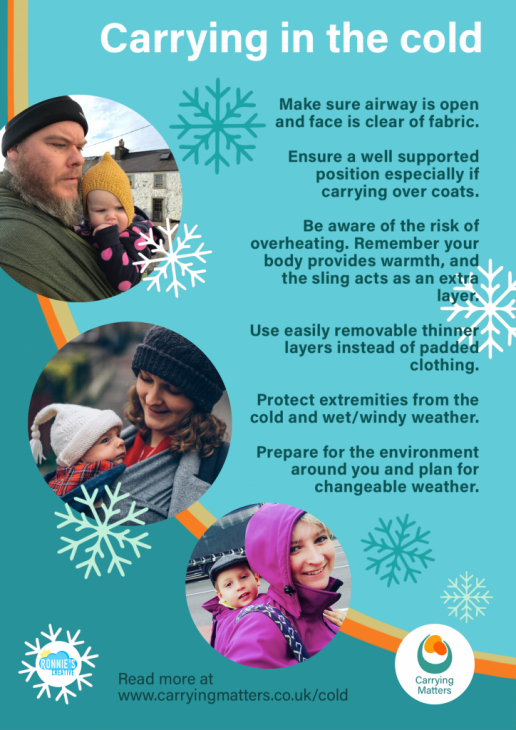
Here is some more information about cold weather carrying from other sources
http://southlondonslings.co.uk/2013/11/12/carrying-in-the-cold/ and
http://stroudslingmeet.wordpress.com/2014/09/20/slinging-in-the-rain-and-cold-and-wind-and-snow/
Here is the link discussing winter coats and car seats..
Blog post originally written 2014, updated Dec 2017
Bonding with your big kid
Bonding with your big kid is just as important as bonding with your baby. Older children need love and secure attachment relationships too, as their brains are still growing and their foundations still being laid down.
“I wish I had known about slings when I had my first child!”
“My son suddenly wants to be carried all the time suddenly and he’s so heavy now, I feel like we missed the boat.”
“My big girl is finding it hard with our new baby and seems to be much more clingy than usual. I wish I could carry her somehow..”
Do any of these comments seem familiar to you? I hear this kind of thing almost daily, and while part of me rejoices that now, at least, these parents do know how fantastic slings can be for family life, I appreciate their sadness.
But did you know, big kids like to be carried too? How many of us have hoiked our hefty toddlers onto our hips when their legs get tired of trundling along, or felt little arms wound around our necks when they are tearful? How many of our huge preschoolers still appreciate long hugs and piggyback rides? All children need closeness, long beyond the baby stage, long after they take their first steps, long after they start school… and so do grown ups! Loving contact is vital to our emotional health, from cradle to grave.
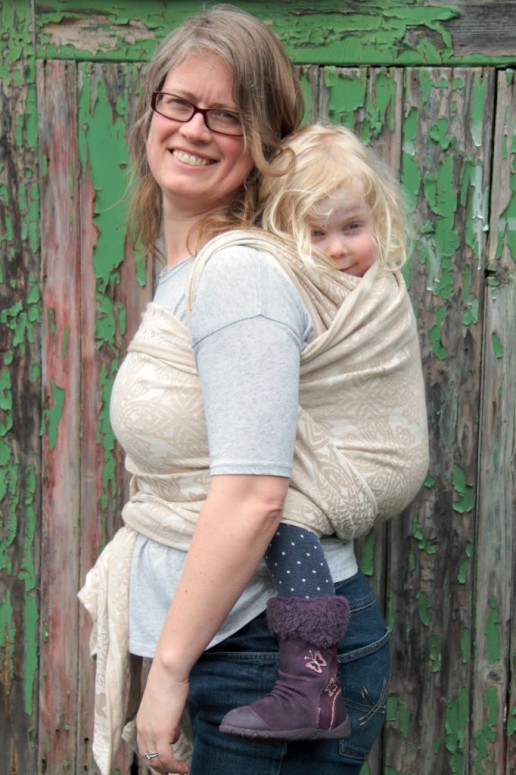
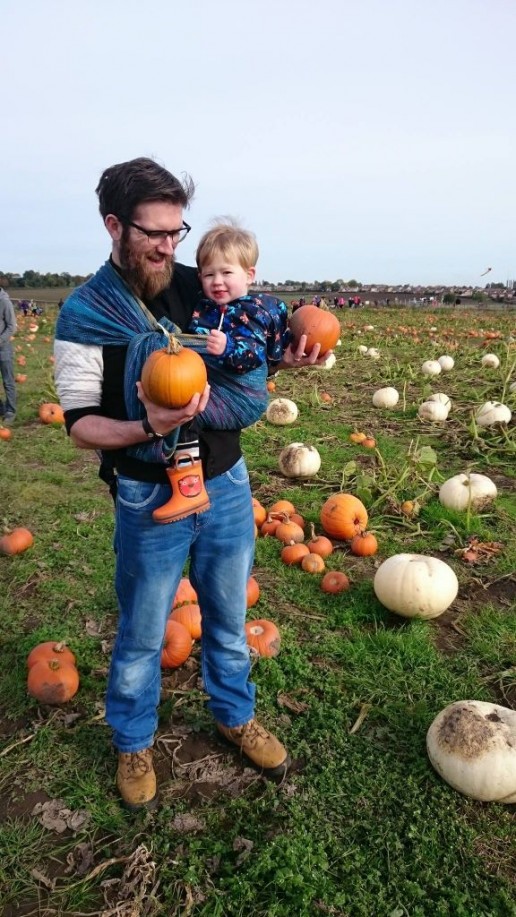
A sling is, at its most basic, a tool for enabling close contact, almost like another pair of enfolding arms around your child, while your real arms can be used for other things. A good sling, when used well, provides a feeling of all-around gentle pressure, as if being hugged all over. This can be very valuable for children struggling with sadness, with sensory overload, with tiredness, or fear from loud noises, for example. Being close to a parent’s body is reassuring and sends a valuable message to a child that “You are loved. I will look after when you are unhappy, I will keep you close when you need it. I am always here for you.” There are many other advantages to slings beyond this opportunity for connection; not least that they can be very comfortable and help to distribute the weight of a child around your body evenly, making it much easier and much less tiring than in-arms carrying. They can help to provide nourishment – breastfeeding or bottle feeding on the go, they can make school runs easier, allow greater freedom in exploration, enable naps, and keep exuberant runners out of danger in crowded areas or near roads etc.
Slings with Big Kids
You can use pretty much any kind of sling with a bigger child, even a stretchy, if it is a high quality hybrid one like the JPMBB or the Ergo wrap. I’ve helped a couple of parents with toddlers find the stretchy love, as there’s nothing quite like the enveloping gentle bounce you get with these. They do tend to work best and most easily in front carries.
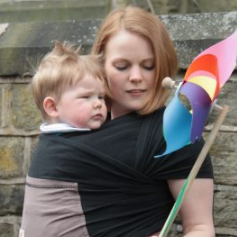
Ring slings can be fantastic, if you have the shoulder style that suits you best (pleated vs gathered), and made of a fabric that is supportive enough. People often suggest linen or hemp or silk to add strength to the softness of cotton, which indeed they do, but many 100% cottons are more than sturdy enough for heavy children, who can become easier to carry as they develop more core strength and become more compliant and easier to carry than the “bowling ball stage” – it’s worth trying a few out!
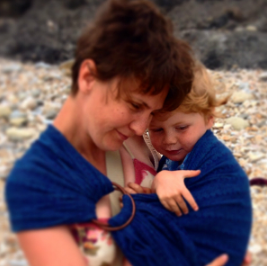
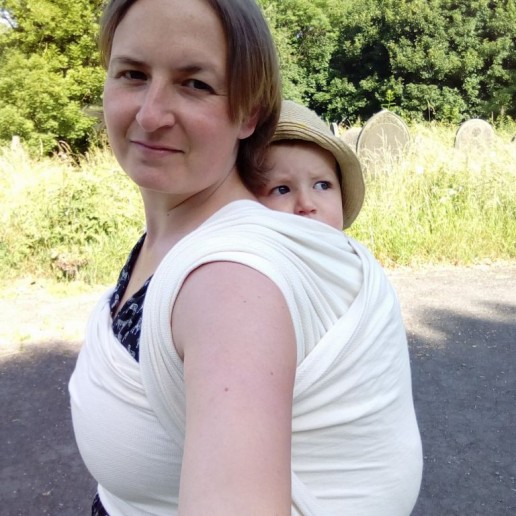
Woven wraps are the most versatile, as they can be tied in different ways, in different positions and with different levels of support. As with ring slings, the fabric used can make a difference to how a wrap feels – fibres with extra support can be helpful but may not be necessary, and as above, understanding tightening techniques and how to get a good position can really help you make the most of your current wrap
You can get toddler size meh dais, half buckles and full buckle carriers, even some up to preschool size. Again, it is worth trying a few out at your local sling library as one size does not fit all, and the body size and shape of the carrying parent plays a part too (some preschooler carriers will just be too big for petite mums, for example). Waistbands may need to be worn lower (around the hips) for front carries, and some creative methods for getting a good seat in a back carry may need to be employed! Please do take advantage of your local sling professionals about whether you need a bigger carrier for your child; it may be that your current carrier just needs a few tweaks in technique to get the most out of it. Many people upgrade to toddler carriers earlier than really necessary, and too big a carrier may be more problematic than one thats just a touch small (see my “beyond the knee to knee” article for more information).
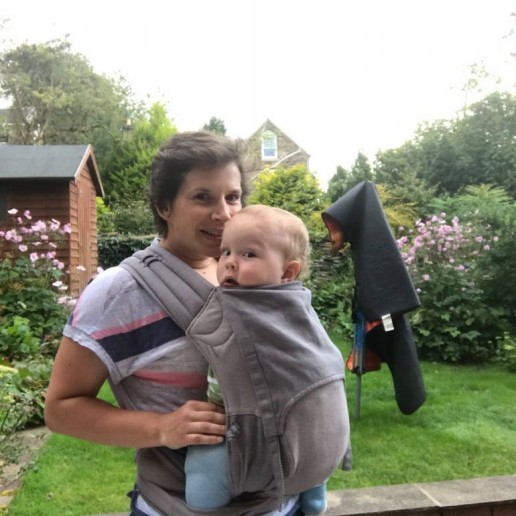
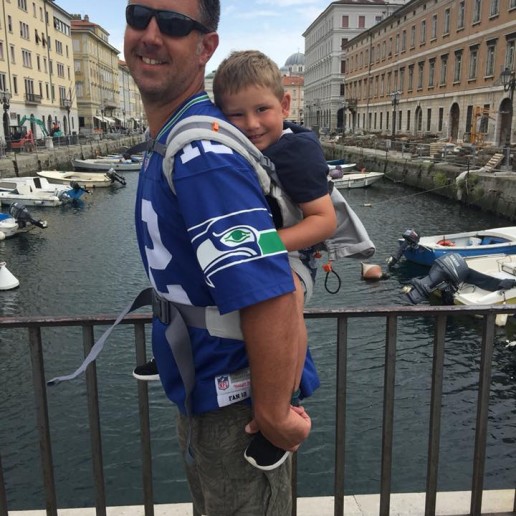
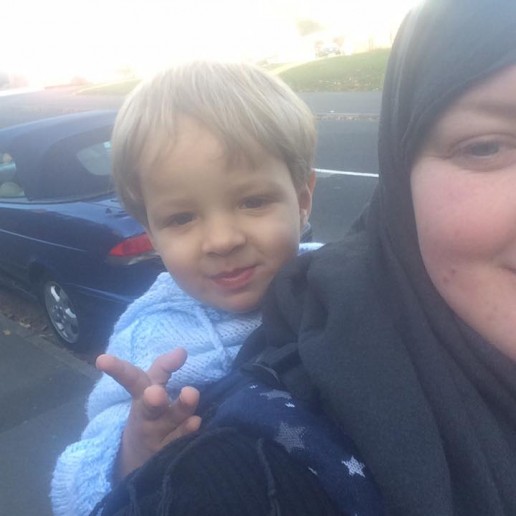
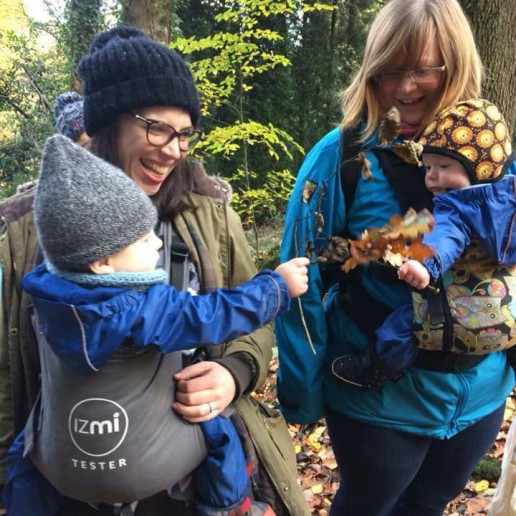
What about the inevitable comments “he’s too big to be carried like that, he should be walking!” or “You’ll just make that child clingy, you know”? Well, I think a sling is as valid a means of transport as a pushchair, and far more comfortable than achingly weary in-arms carrying. Don’t be afraid to carry your toddler – for every comment you get, you may well have planted an idea in someone else’s head. Ensure that your child doesn’t feel hurt by any comments, sometimes talking about any incidents together afterwards can be helpful. Using a sling for your bigger child from time to time will not harm them, nor will it make them babies again, any more than a hug or a hip carry would do.
My own experience
My big girl, who was nearly 4 at the time of writing, is much less often carried these days; much to my chagrin.. but she is vocal about it when she does want to be carried, climbing up me and wrapping her legs around my waist. I am happy to oblige as I’m never sure how many more carrying days we have left to enjoy. She has moods, and disappointments that the world doesn’t revolve around her, and sometimes she finds it hard to wind down. Often, at these moments, a sling has been our saviour, holding her close so she can relax, feel safe, and listen to my reassuring murmurs, while I can still get on with some of the things that just can’t wait, or save my back and arms from her lopsided weight! We use all sorts of carriers – ring slings for quick up and downs, woven wraps for sleepy cuddles, preschooler buckle carriers for rainy school runs, warm snuggly half buckles for winter walks.
Even my (then) six year old found a wrap carry a great reassurance one day when he got separated from us at the Yorkshire Sculpture Park; he was very distressed when found half an hour later and just wanted to be holding onto me. My husband’s shoulders got pretty tired after a few minutes; but I was able to carry F on my back for well over half an hour, due to the support and the weight distribution, enough time for him to feel reassured and connected again. I found it really helpful too – it was a pretty horrible forty minutes and having him in close contact was very valuable for my own feelings and allowed me to breathe and absorb, and move on.
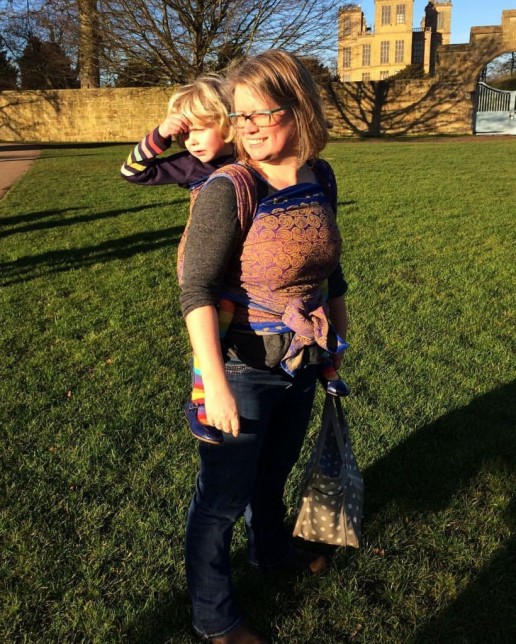
A local story of re-connecting with a sling
I’ve got to know one family with a preschooler pretty well, they hadn’t used a sling for over a year, but started again, almost from scratch. Here’s what they have to say about their experience of carrying a bigger child.
After starting nursery, H became anxious and disconnected. She chewed her fingernails to a painful point, and became difficult to communicate with, as well as regressing in toileting. Instead of adopting behavioural control techniques, I drew on my experience from other parts of our lives and adopted a regression tactic. A big part of this was returning to carrying her in a sling. We had used our high-street carrier rather than a pram on our dog walks, but had given this up over a year before as she had outgrown it. We wondered if a ring sling would be a solution for short snuggles for reconnecting. H was too heavy to attempt this from online videos, so we booked a workshop with a local sling consultant, who reassured us that she wasn’t too big, and showed us how to ensure we were all comfortable. The ring sling has been perfect for our needs and has really helped us all. More often than not, it has doubled up as a dramatic scarf for the 80% of the time H wanted to walk!
H is now almost 5. Our new buckled carrier is the perfect tool for winding down for bedtime on a camping trip, resting tired little legs whilst hiking (without the bulk of a framed carrier), and elevating her out of danger in busy, crowded areas. I really believe there is no such thing as “too big to sling!”
Slings with Two Kids
Another situation where carrying a bigger child can really help is with sibling jealousy. The other day I spoke to a family who hadn’t used their sling with their toddler for some time, and now have a new baby. Big sister has been feeling a bit jealous of the new arrival and has wanted to begin breastfeeding again. They asked for some advice, and I suggested that their daughter would really appreciate the contact that would come from using their ring sling and buckle carrier again… and so it seems to have proved. It’s not so much the desire to be a baby again, but more of a chance for communication – “you still belong to me, don’t you?”
I’m working with another lady whose older child is struggling to accept their brand new baby. She asked me to show her how to breastfeed her baby in a sling, in the hope that this would allow her to be hands free to play with her toddler. She’d never carried her first child but was loving the slings with the little one. Successful breastfeeding in a sling is a challenge that requires care to do well and safely, and in my opinion is never fully hands-free. However, one hand available can make a big difference – you can hold a book to read, help with a jigsaw at the table, stir a mixture, hold a hand, for example. Amongst other things, we looked at a ring sling, which can be used for little babies as well as bigger children who love to sit on the hip and look around, so it is a carrier that can be used for children of multiple sizes. Hopefully, carrying the bigger child from time to time while the baby is sleeping, or in a pram or carried by Dad will be helpful for dealing with big feelings and the need to know that his Mum is still Mum and will always be there to meet his needs, even with the new addition taking up so much of her time.
There are some carriers that can be used with small babies and bigger children; which means the same carrier can be used for both children when needed. The ultra- versatile ring sling and woven wraps are good examples, which mould around the parent-child dyad and can be used from birth to preschool age and beyond.
Some mei tais with adjustable width can work well for families with children born with a small age gap. The buckle-waist equivalent half-buckles can be useful, or those with wide wrap straps that can be tied in such a way that bigger children will be supported knee to knee. Some full buckle carriers can be used from birth and their panels can be adjusted to the size of the child. Some come with inbuilt adaptations for using with babies, and some have separately purchased inserts for small babies to rest on until they grow big.
Do visit your local sling library or get in touch with a sling consultant for some help navigating all these options; there will be something to suit nearly every situation!
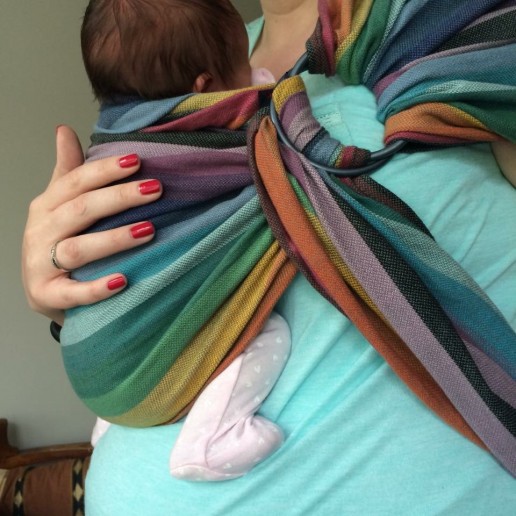
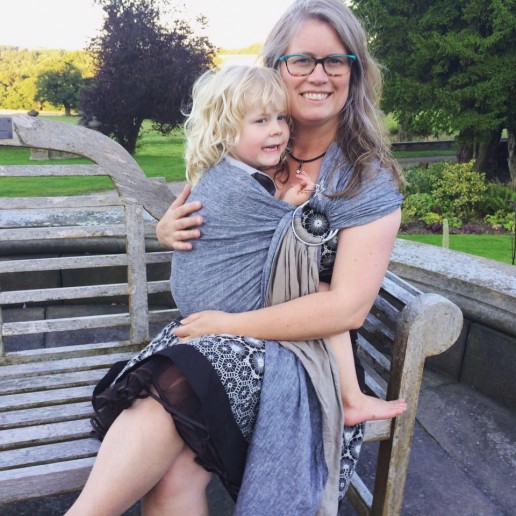
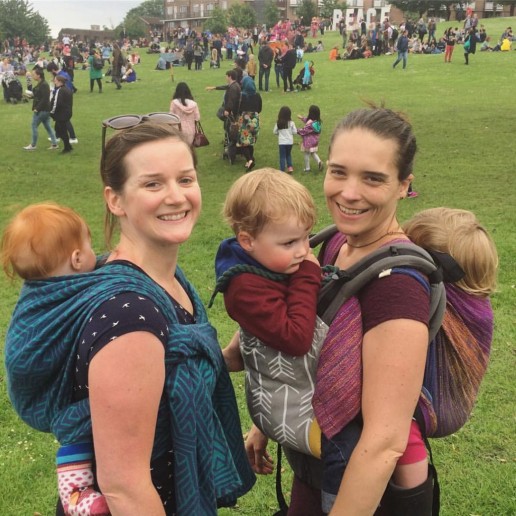
Slings during Pregnancy
During pregnancy, carrying an older child can be an opportunity to help deepen relationships and prepare for the new arrival, being reassuring that things really are going to be all right after all. Carrying while pregnant has its own challenges too; ensuring the bump isn’t compressed, that weight is well distributed, that any symphysis pubis discomfort is not exacerbated. Do see your local sling consultant or chiropractor or physio for help if you need (bearing in mind that many health care professionals may not be up to date with ergonomic, safe carriers.) There is more reading here about carrying while pregnant.
In summary, older children do not stop needing the love and support of their caregivers for a surprisingly long time. Our society seems to believe that we should encourage separation of children and caregivers as young as possible, to breed “independence”, when actually, neurophysiology suggests that children will learn independence at their own pace, as their cognitive and emotional capacities develop.
Secure Attachment and the "Fourth Trimester"
Secure attachment is the deep and enduring emotional bond that connects one person to another across time and space; a "lasting psychological connectedness between human beings" (Bowlby/Ainsworth).
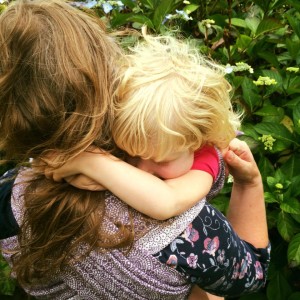
Research shows that one of the strongest predictors for insecure attachments in children is to have a parent who lacks secure attachment themselves.
So, how do you build a secure attachment relationship with your child?
Secure attachment is created by loving responsiveness to your child's needs. It is not about your parenting style. Your baby may sleep in a crib or your bed, be fed from a breast or a bottle, be held in arms or a sling, be weaned in any style, be brought up by any combination of carer and still have secure attachments. It is not about subscribing to a particular parenting philosophy. You do not have to sacrifice everything - your identity, your sanity, your relationship, your job, your money or anything else at the "altar of childhood".
Building secure attachment is about having respect for a child's personhood, building their sense of self-worth within a consistent, loving and responsible relationship, regardless of their age or understanding.
Your child's humanity is as valuable as your own; neither more nor less. You are your child's advocate in the world and their greatest defender. You can provide for their every need, and they depend entirely on you and your surrounding network. They will learn whether or not they matter from how they are treated and how their requests for support are met. Securely attached children are confident that they will be cared for, and that any distress will be met by love. They are easily soothed by their caregiver when upset, are more able to be self-reliant, form positive relationships and generally have smoother paths through life.
However, their needs need to be balanced with that of the family, as a crumbling family dynamic will ultimately not be in anyone's best interests.
The "fourth trimester" is where attachments begin to form.
What is the Fourth Trimester?
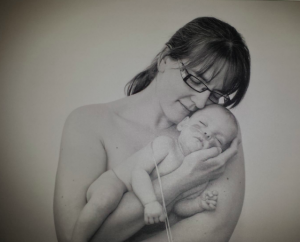
The ‘fourth trimester" is the period immediately after birth, a few more months of intense nurturing to allow a baby to continue with their essential development from a place of security and safety.
A baby who has spent all their life growing peacefully in the womb, gently compressed by uterine walls at the end of the third trimester, will find the sensation being born, followed by freedom and open space in the outside world enormously different. Limbs that have been limited are suddenly free to stretch wide, darkness has turned to light, the muffled gentle rhythmic sounds of the mother's body have been replaced by loud, unfamiliar noises or deep silence. Constant gentle motion has turned into complete stillness or sudden movements. No wonder that when babies are held close, rocked and soothed, contained in soft boundaries once more, that they settle; this feels right and familiar.
The "fourth trimester” is all about gentle transitioning from the peace and stability of the womb towards active involvement in a new world.
A newborn needs to be supported to gain skills and strength at a steady, individual pace from the security of an unshakeable foundation and place of comfort and familiarity. Being held, close to familiar noises and scents is essential to development and positive learning; the infant brain is growing rapidly and forming new connections all the time. Connections that are reinforced frequently will persist into later life, whereas those that are rarely used will wither away. It is worth taking the time to ensure that these unconsciously forming connections are positive ones. Young infants do not have the cognitive development to behave in "manipulative" ways; but they do learn to trust someone who proves reliable time and again as these pathways are reinforced. They will be startled and upset when this love is withdrawn.
The importance of responsiveness
If you are sensitive and responsive to your baby as they begin to communicate their needs with you (by crying, wriggling, yawning etc) they will learn that they matter to someone. If they are uncomfortable, the people they are learning to trust will soothe them. When they are hungry, they will be fed, when they are tired, they will feel secure enough to sink into sleep. They will not be frequently left alone unattended for long periods of time, and will not be left to exhaust themselves in calling for someone who never comes. When they cry, loving arms will be there to comfort and keep them safe. These same arms will show them the world and provide a safe place that facilitates learning. Carrying matters; babies need it. It does not make them clingy, rather, the solid foundation of secure attachment relationships will be the springboard to confident independence later in life.
How does babywearing help?
One tool that can help you meet your child's need for loving contact in these early months is a soft carrier that holds them in a comfortable, safe and anatomically respectful position. Such carriers will help you to meet their needs to be close to you while allowing you to be hands-free for daily life. There are many other positive reasons to carry a child; such as reduced crying, reduced plagiocephaly and more. Parents benefit too, for example carrying can be helpful for those with postnatal depression, and increase overall activity levels. This idea is not new; most of the world’s families across history and cultures have used some form of sling to make life work.
You can find out more from your local sling library or consultant; there are hundreds across the UK. They will help you to find the right type of carrier for your needs.
What about my older child?
Attachment relationships continue to form beyond the early months and children's brains are very "plastic". Warm, responsive, emotionally available parenting will help to build a child's sense of self-worth at any age. There is evidence that "mind-minded" parents (ie those who treat their children as intelligent, relational individuals with feelings, and speaking to them in such a way) seem to have children with more secure attachments. Active play and laughter, as well as consistent loving boundaries help to reinforce neural connections that the primary caregivers are a reliable source of security; forming strong foundations for the future. Read more about how carrying can help the learning brain.
References
Bowlby J. (1969). Attachment. Attachment and loss: Vol. 1. Loss. New York: Basic Books
Ainsworth, M. D. S. (1973). The development of infant-mother attachment. In B. Cardwell & H. Ricciuti (Eds.), Review of child development research (Vol. 3, pp. 1-94) Chicago: University of Chicago Press.
Ainsworth, M. D. S., Blehar, M. C., Waters, E., & Wall, S. (1978). Patterns of attachment: A psychological study of the strange situation. Hillsdale, NJ: Erlbaum.
Sutton Trust; Baby Bonds Parenting, attachment and a secure base for children. March 2014 Research by Sophie Moullin, Jane Waldfogel and Elizabeth Washbrook
http://www.parentingscience.com/attachment-parenting.html
Rethinking Maternal Sensitivity: Mothers’ Comments on Infants’ Mental Processes Predict Security of Attachment at 12 Months; J. Child Psychol. Psychiat. Vol. 42, No. 5, pp. 637–648, 2001

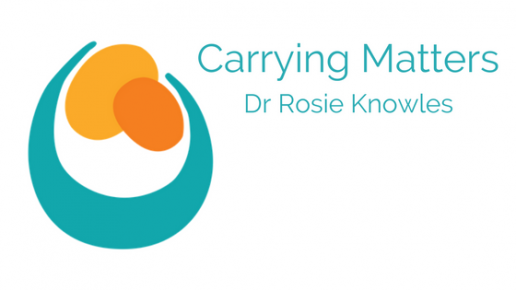
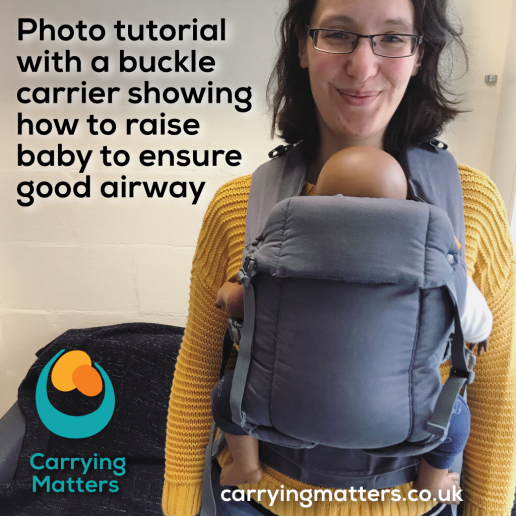
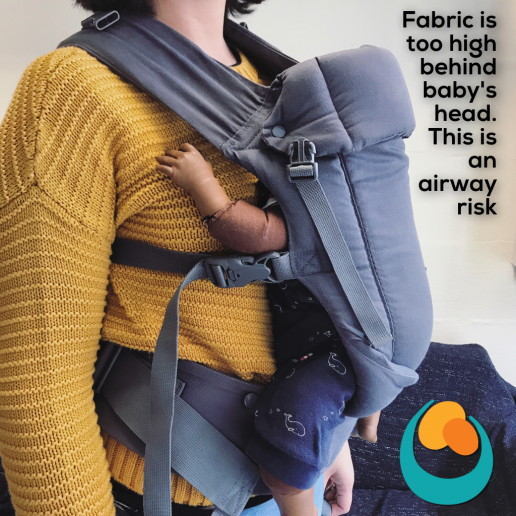
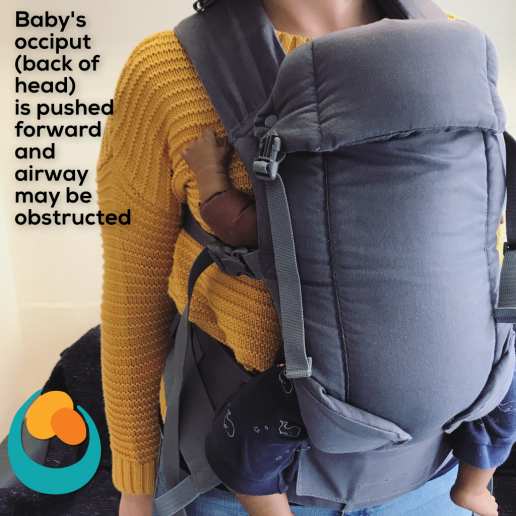
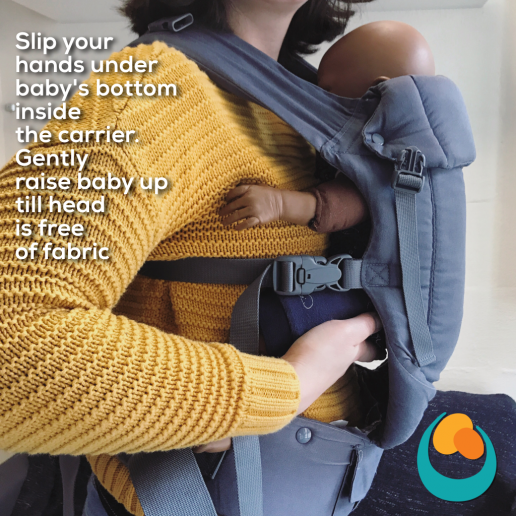
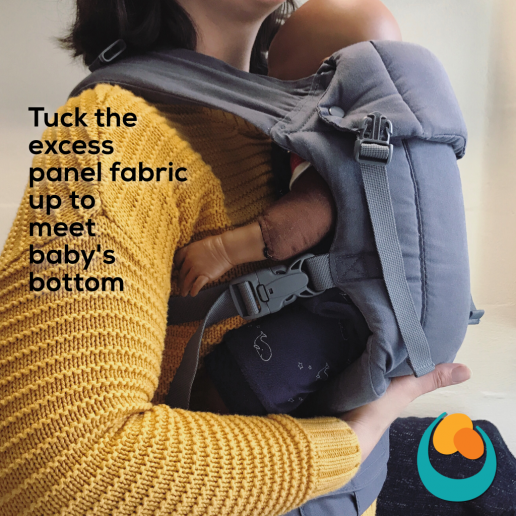
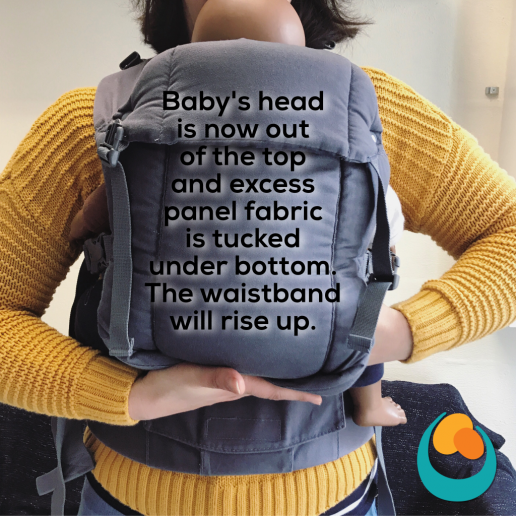
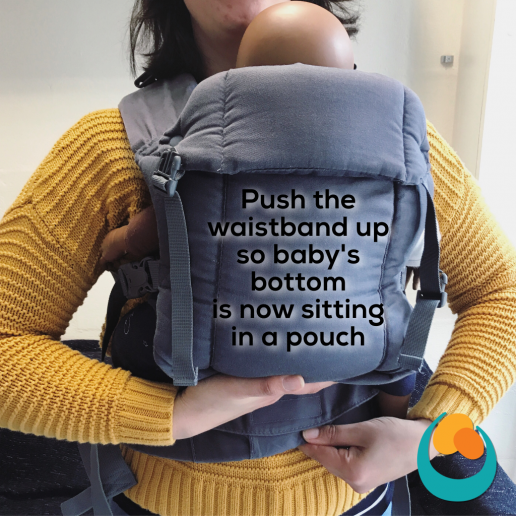
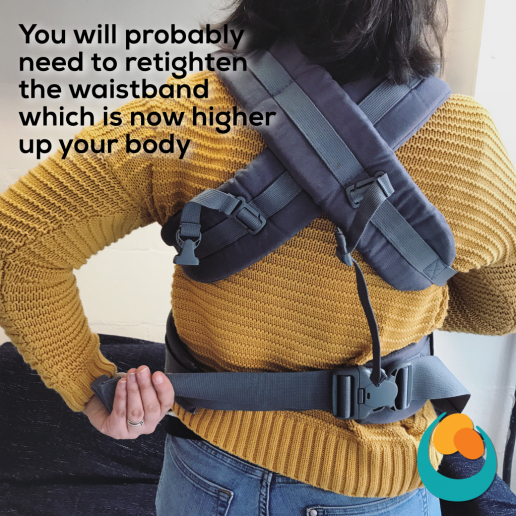
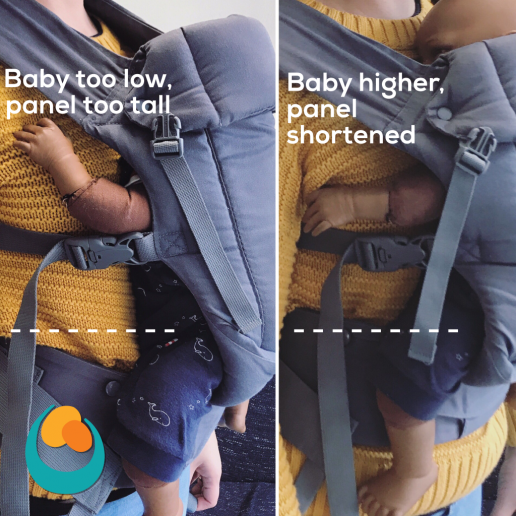
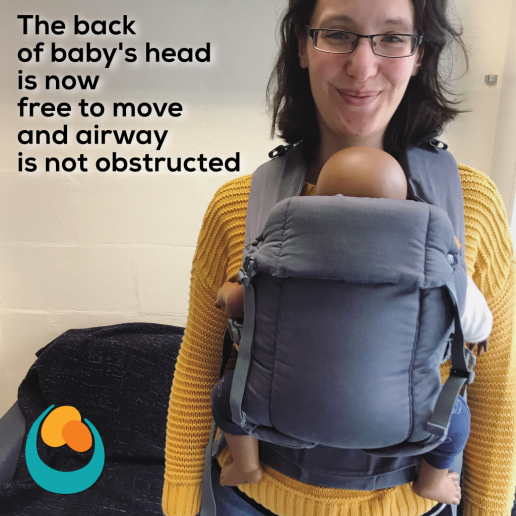
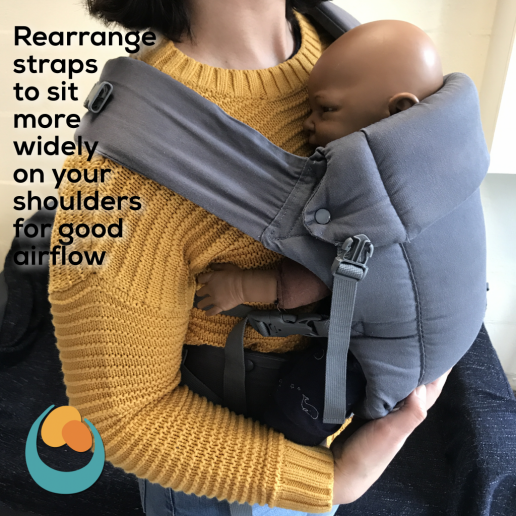
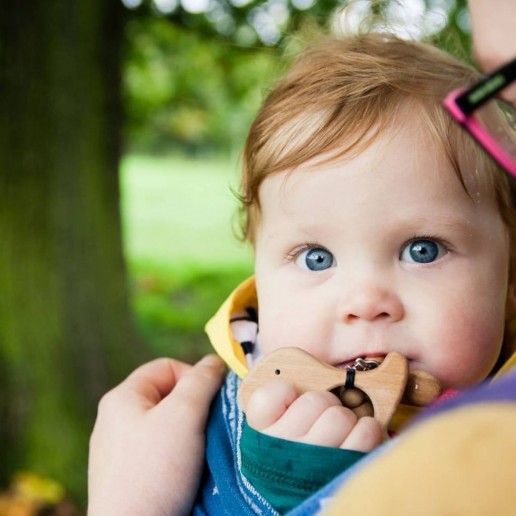
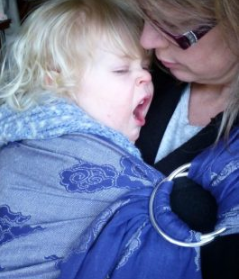
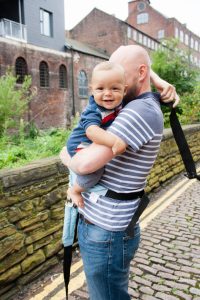 Get confident with a demo doll first. Sling libraries and sling consultants are usually well stocked with weighted demo dolls which will allow you to figure out how to use the sling safely (remember the
Get confident with a demo doll first. Sling libraries and sling consultants are usually well stocked with weighted demo dolls which will allow you to figure out how to use the sling safely (remember the 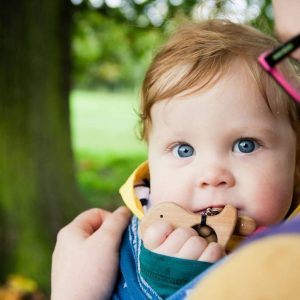
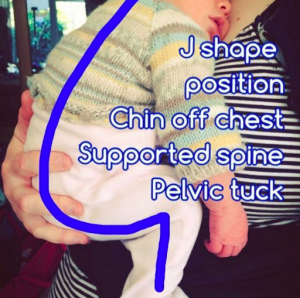
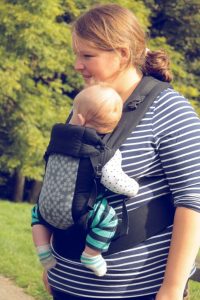 Remember that your baby still wants to experience the world even while carried, as they do when playing on your lap or on the floor. Help them to be able to see a little, in a way that is appropriate for their age and still respectful of growing spines and hips. A carrier that has straps or fabric that comes close to the face may be irritating (do remember that babies grow taller, and many carriers can be adjusted to ensure faces and heads not obscured). Make sure that there is some activity going on - we all know about the sway we do to settle babies when carried in arms, and how often we shift them around, or the rocking/pushing of the pram - this gives a child some sensory input, rather than remaining still. I often encourage parents to go for a short walk round the block when they have just put a sling on with their baby - the motion and movement to get out of the house and the fresh air and change of scenery usually works wonders and parents come back with happier babies. Of course, once the parent is standing still again, and baby is bored with the reduced activity, he will protest!
Remember that your baby still wants to experience the world even while carried, as they do when playing on your lap or on the floor. Help them to be able to see a little, in a way that is appropriate for their age and still respectful of growing spines and hips. A carrier that has straps or fabric that comes close to the face may be irritating (do remember that babies grow taller, and many carriers can be adjusted to ensure faces and heads not obscured). Make sure that there is some activity going on - we all know about the sway we do to settle babies when carried in arms, and how often we shift them around, or the rocking/pushing of the pram - this gives a child some sensory input, rather than remaining still. I often encourage parents to go for a short walk round the block when they have just put a sling on with their baby - the motion and movement to get out of the house and the fresh air and change of scenery usually works wonders and parents come back with happier babies. Of course, once the parent is standing still again, and baby is bored with the reduced activity, he will protest!